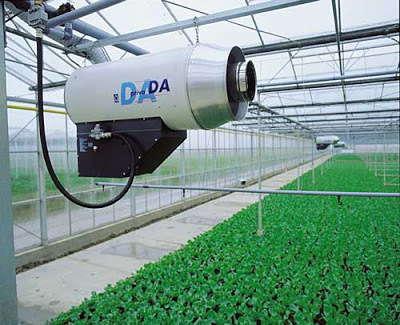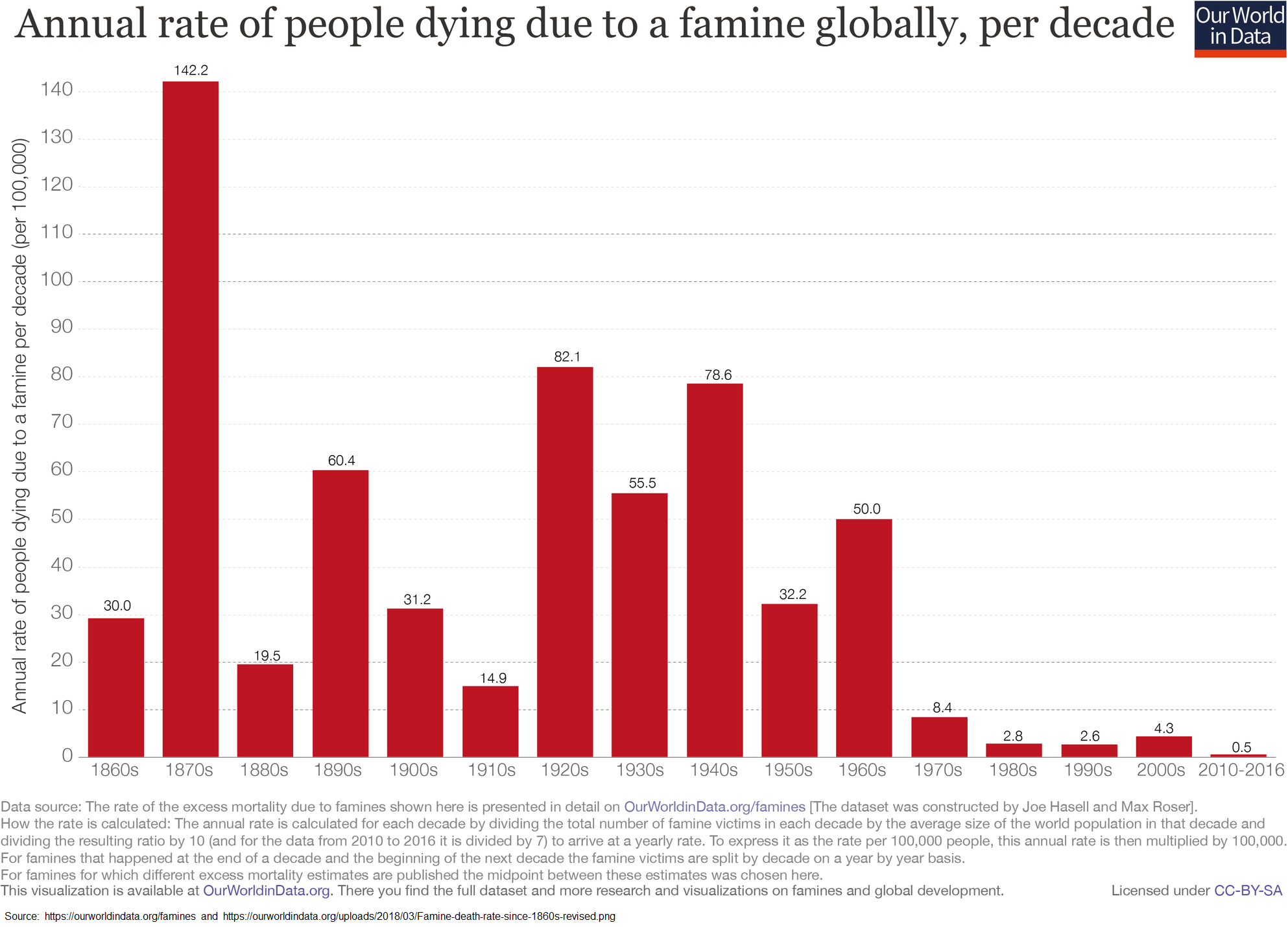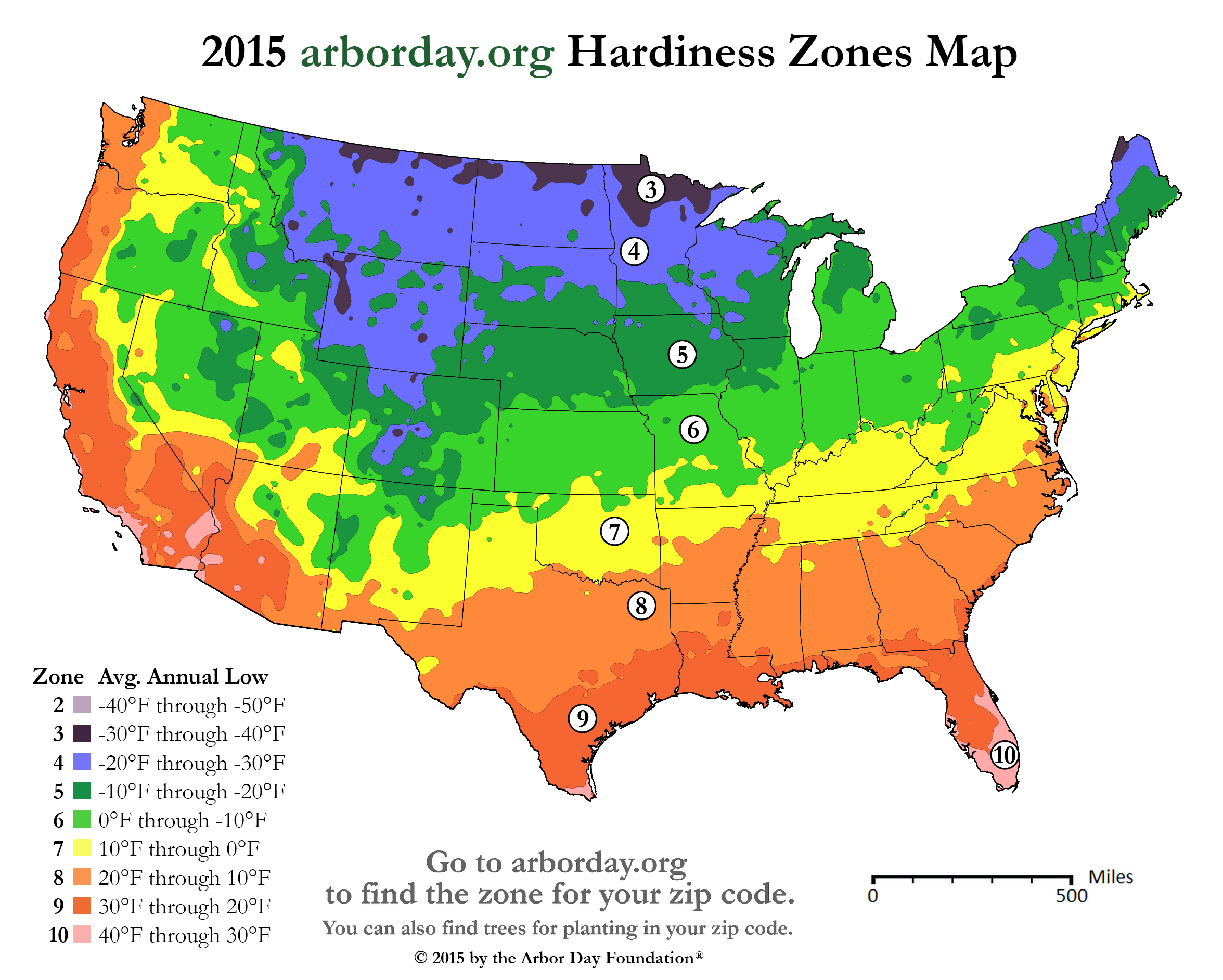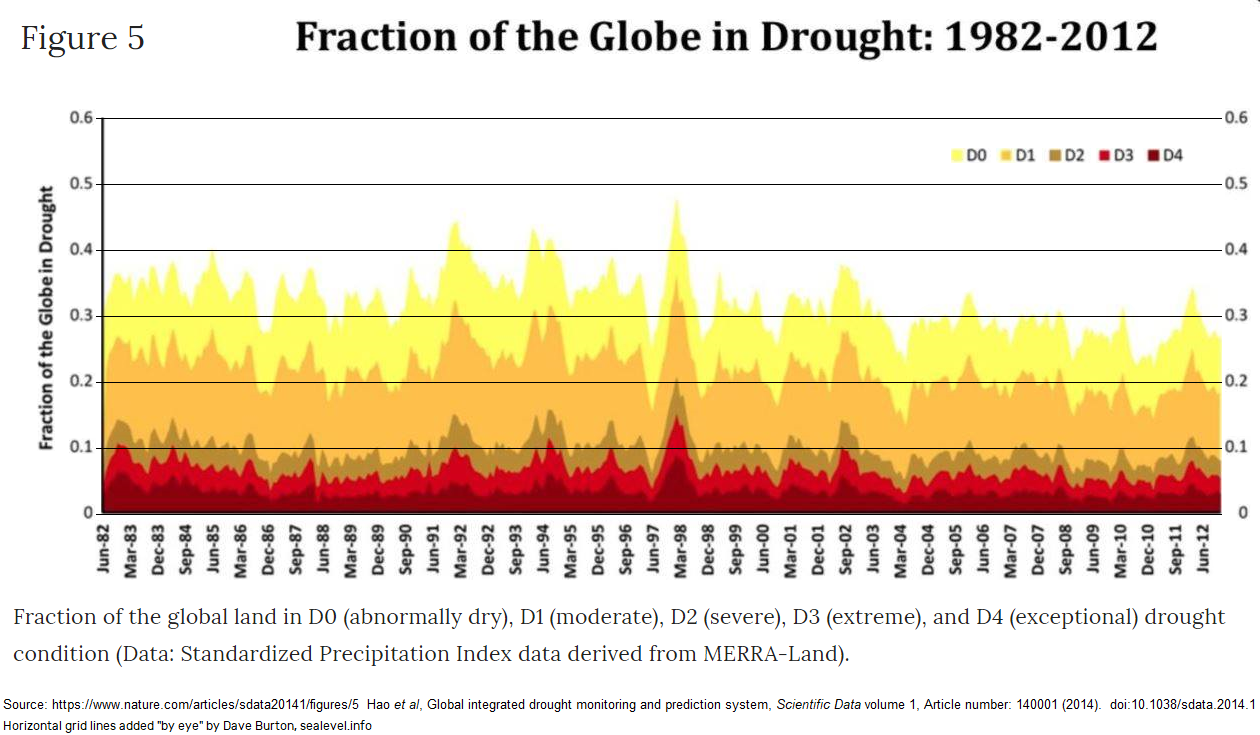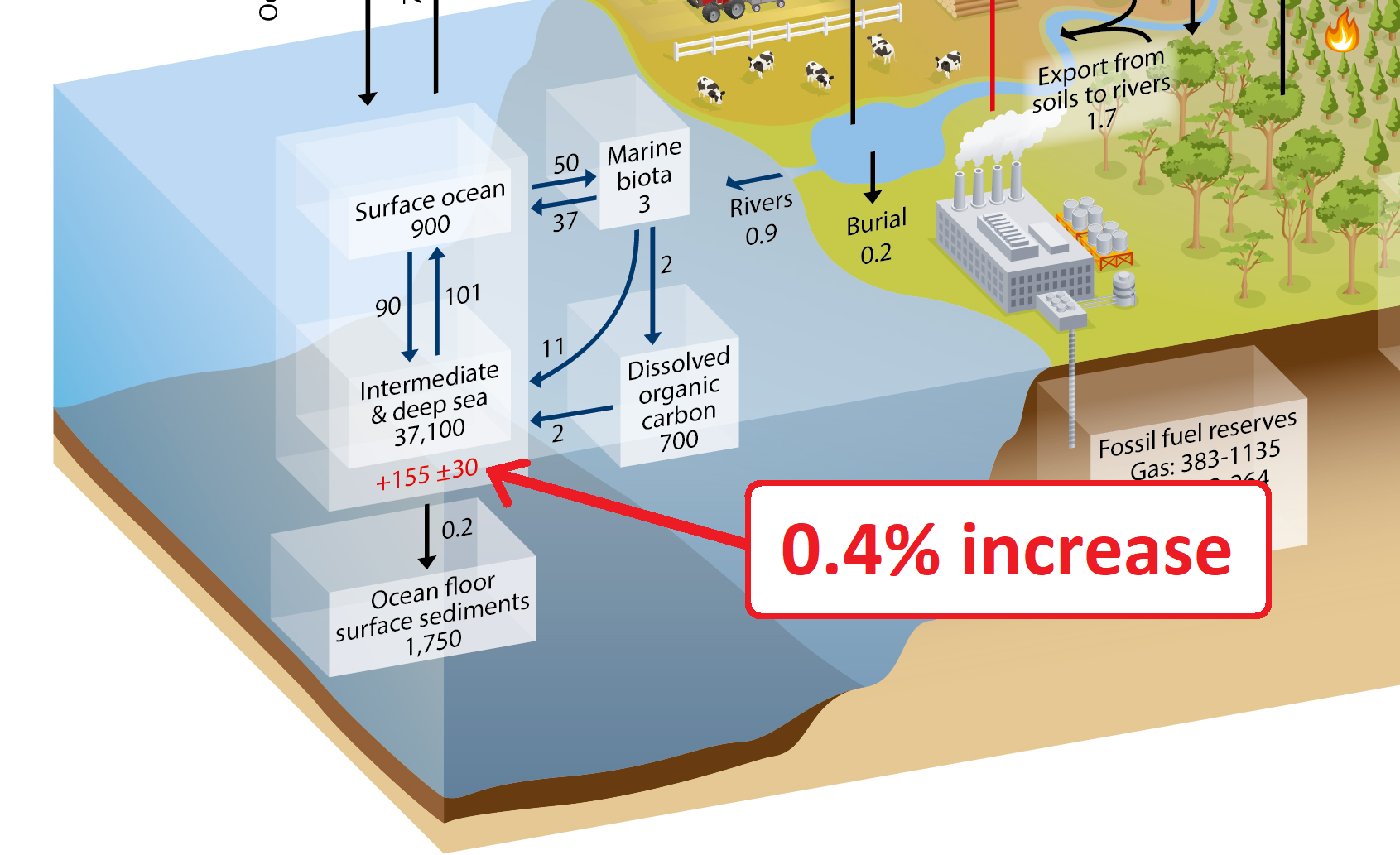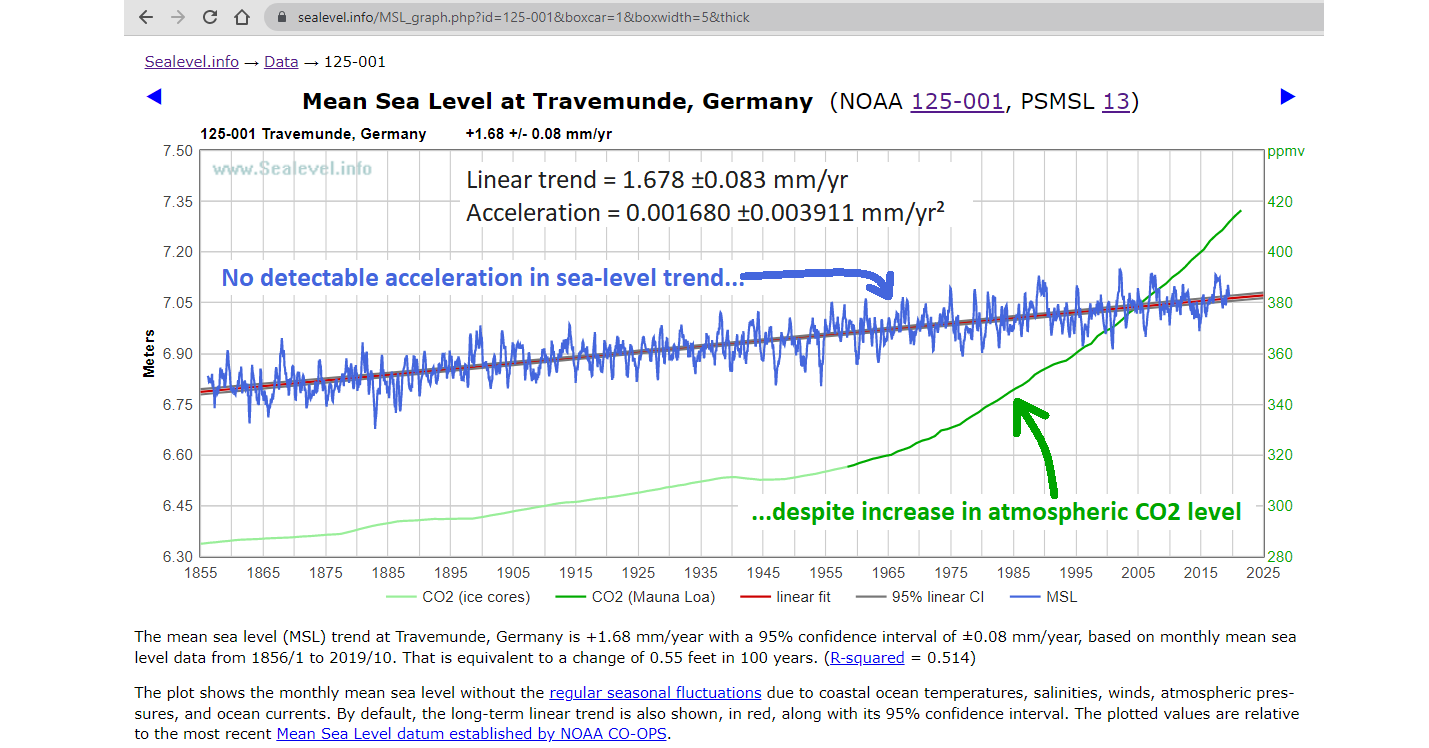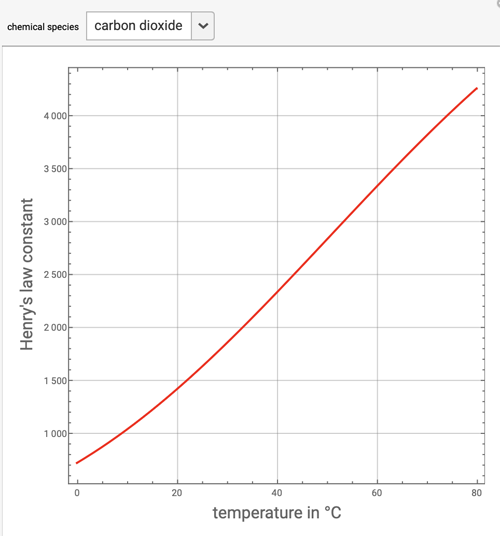Recent Comments
Prev 27 28 29 30 31 32 33 34 35 36 37 38 39 40 41 42 Next
Comments 1701 to 1750:
-
Bob Loblaw at 06:06 AM on 14 July 2023How big is the “carbon fertilization effect”?
Yes, Daniel, Mr Burton certainly is consistent in wandering off topic in his comments. At least in this case he followed it off the Hansen post, but now he is mixing in CO2 fertilization and drought.
He is also showing his years of experience in picking cherries.
So many of the "CO2 is plant food" argument depend on studies in greenhouses, etc, where other limiting factors are not limited. The SkS post "Plants cannot live on CO2 alone" provides background. That may be a better place to continue this discussion.
As for his drought comments, he has picked a global diagram (figure 5 out of the Hao et al paper he references) that contains absolutely no regional information at all.
Figure 2 from that paper (available online) shows some examples of the regional droughts as detected by their methodology, but the paper does not provide any information about regional trends. The figure (below) does indicate that "global" really is rather global. I suspect that changes in the desert zones (look at the Sahara) or high latitudes have little effect on agricultural productivity.

Mr. Burton's U.S. drought trend also suffers the same failure: ignoring regional trends. It is also purely a precipitation-based wet/dry analysis - not looking at the important temperature effects on drought. And each classification of "very wet/very dry" is solely an indicator of whether each region is wetter or drier than its own regional value - which tells us very little about drought. Quoting from the original source:
Climate divisions with a standardized anomaly in the top ten percent (> 90th percentile) of their historical distribution are considered "very warm/wet" and those in the bottom ten percent (< 10th percentile) are classified as "very cold/dry".
A normally very wet area that is only seeing precipitation in its bottom 10 percent will in all likelihood still be getting more precipitation than a normally dry area that is in its top 10 percent. The student that typically gets 85-95% on exams and score 85% on this one still gets a better grade than the student that typically gets 65-75% on exams and scores 75% on this exam.
If you start to look at regional patterns, other features begin to emerge. SkS had a re-post of a 2018 Carbon Brief article that looks at specifics. It gives a good explanation of the factors other than precipitation that need to be considered. When it comes to agriculture, even the "correct" amount of precipitation can be bad if it is at the wrong time. Fields that are "too wet to plough", crops ready for harvest that are rotting in the fields and can't be harvested, etc.
As usual, Tamino does an excellent job of taking data and picking out regional patterns. He did one in 2019, looking at "The West Burns and the East Drowns - so it averages out, right?". Spoiler alert: the two regions show different trends. Borrowing two of his images:
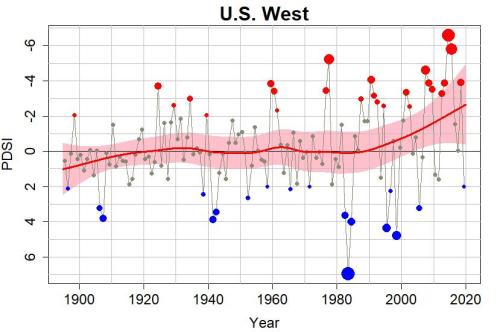
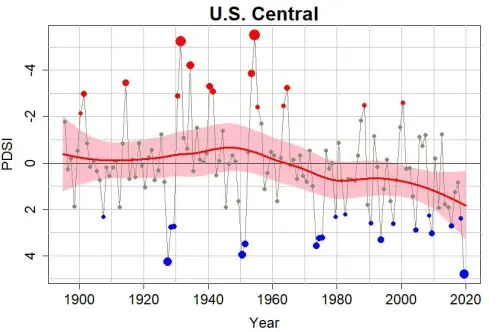
Tamino also had a post in 2018 about US drought patterns. Again, there are major regional differences, with the west (especially the southwest) getting drier, and the northeast getting wetter.
The sort of analysis that Mr. Burton is presenting is the kind of argument that leads one to conclude that the average person has one testicle and one breast.
Follow-ups on the drought discussion should probably be removed from this thread and posts on the 2018 Carbon Brief article repost.
-
Eclectic at 05:59 AM on 14 July 2023How big is the “carbon fertilization effect”?
Daniel Bailey @25 ,
Yes, agreed, the off-topic is strong . . . and the copying-and-pasting is strong . . . and the Motivated Reasoning is strong. Twas ever thus, on the Dark Side of the Force ;-)
Daveburton @24 ,
Thank you ~ and you are quite correct about the [magnitude of] reduced nutritive value of crops in some circumstances. I mentioned the matter briefly (as a one-liner) as a reminder that one is dealing with vastly complex biological systems . . . and that one should avoid having a religious fervor for the undoubted benefits of high CO2 for [most] plants.
Daveburton, you get yourself in a tangle by your third paragraph. "No possible mechanism" [unquote] by which a higher CO2 level could cause an increase in natural carbon sink rate? An examiner would quote that as a Howler, to be circulated for the amusement of his fellow markers. # Dave, possibly you were expressing yourself extremely poorly . . . but either way, you go on to contradict yourself in one of your later paragraphs. And you re-contradict yourself in yet another paragraph. [ Is "re-contradict" an English word?]
And then you re-re-contradict yourself soon after.
[ Oy Veh to the O.E.D. ]
Moving on . . . Daveburton, you are looking at the world through a straw. Please look at the whole world, not just the 49-state USA. Droughts /floods /heat-waves already are (and will be) increasingly problematic, thanks to AGW. Unfortunately, the important staple crop maize [yield] is exceptionately sensitive to high and/or prolonged heat-waves. Luckily, other staple crops are "not quite so much" . . . but the plant geneticists have their work cut out for them, to keep up with future changes.
-
mm at 04:35 AM on 14 July 2023OA not OK part 20: SUMMARY 2/2
Hi, I was wondering why CaCO3 precipitate precisely on plankton and shellfishes. Are they catalizing the formation of CaCO3 (i.e. changing some of the reaction cinetic in some ways) locally? If so, what is the contribution on the overall slow C cycle? Would it "turn" much slower if they weren't there?
PS: Thanks for this amazing website :)Moderator Response:[BL] Please avoid posting the same comment on multiple threads. It leads to a fragmented discussion when people respond.
Readers will find all recent comments on the Comments page. There is a link to that page in the middle of the menu, just below the main header.
-
mm at 04:32 AM on 14 July 2023OA not OK part 13: Polymorphs - the son of Poseidon
Hi, I was wondering why CaCO3 precipitate precisely on plankton and shellfishes. Are they catalizing the formation of CaCO3 (i.e. changing some of the reaction cinetic in some ways) locally? If so, what is their contribution to their catalization to the overall slow C cycle? Would it "turn" much slower if they weren't there?
PS: Thanks for this amazing website :)Moderator Response:[BL] For readers wanting to respond to this, please note that the question was asked twice, on two different threads. Please do not respond here - place all responses on the other thread.
-
Daniel Bailey at 04:09 AM on 14 July 2023How big is the “carbon fertilization effect”?
The off-topic is strong in this one.
-
daveburton at 01:45 AM on 14 July 2023How big is the “carbon fertilization effect”?
Eclectic wrote, "Daveburton @22 ~ Please explain more of your first chart [ IPCC's decadal Carbon Flux Comparison 1980-2019 ]. The natural sink flux figures… show a rather steady proportionality to the total carbon emissions."
Glad to. Any two things which steadily increase are thereby correlated. There's only a possibility that the relationship might be causal if there's a possible mechanism for such causality.
There's no possible mechanism by which the rate at which CO2 emerges from chimneys could govern the rate at which CO2 is taken up by trees & absorbed by the oceans, or vice-versa, so the relationship cannot be causal — just as this famous relationship is not causal:
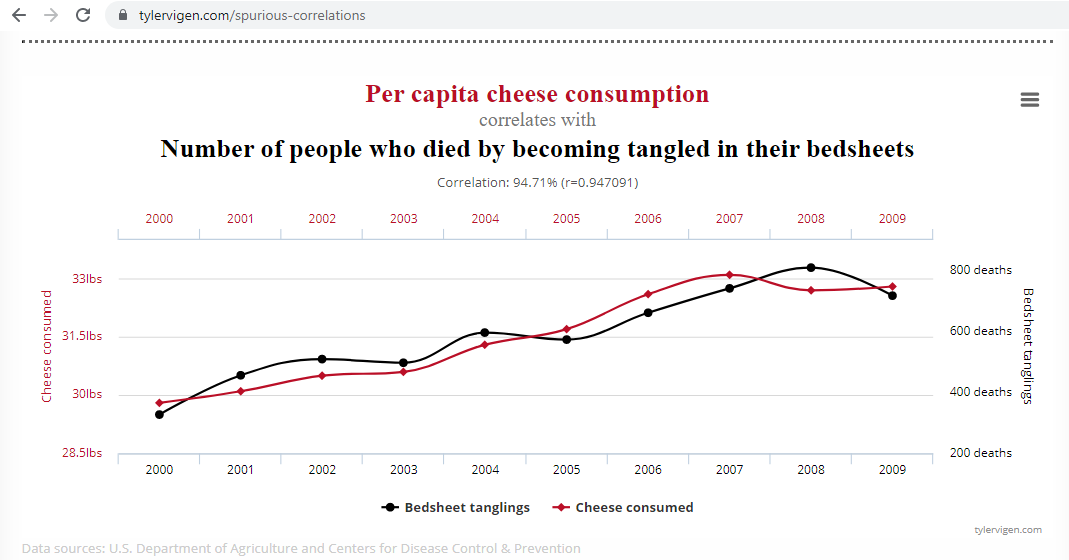
Eclectic wrote, "The land sink shows about 30-35% of total emissions, while the sum of land & ocean remains around 55-60%."
Yes, I usually say "about half," as in, "If our CO2 emissions were cut by more than about half then the atmospheric CO2 level would be falling, rather than rising."
It is important to recognize that the relationship is merely coincidental, not causal.
Eclectic wrote, "as the decades progress, the natural carbon sink flux in absolute terms rises with the rising emissions ~ but does not show a proportional increase."
The rate at which natural processes, such as ocean uptake, uptake by trees and soil ("greening"), and rock weathering, remove CO2 from the air, is affected in minor ways by many factors, but in a major way by only one: the current amount of CO2 in the air.
Our CO2 emission rate does not and cannot affect the natural removal rate, except indirectly, in the long term, by being one of the most important factors which affect the amount of CO2 in the air.
Eclectic wrote, "looking back in time ~ as the atmospheric CO2 level decreases, the size of the natural sink flux decreases also."
That is correct. It will also be correct looking forward in time, when CO2 levels are falling, someday.
Eclectic wrote, "this directly contradicts your hypothesis of 'if emissions were halved ... atmospheric CO2 level would plateau.'"
If you'll allow me to use "halved" as a shorthand for "reduced to the point at which emissions merely equal current natural removals, rather than exceed them," then those two statements are both correct, and perfectly consistent. It's pCO2 (level), not the rate of CO2 emissions, which (mostly) governs the rates of all the natural CO2 removal from the atmosphere.
Of course there are also minor factors which affect the removal rates. For instance, as we've already discussed, a 1°C rise in water temperature slows ocean uptake of CO2 by roughly 3%. Conversely, a rise in air temperature accelerates CO2 removal by rock weathering. (Sorry, I don't have a quantification of that.) But the main factor which controls the rate of CO2 removals is pCO2.
Eclectic wrote, "While the nutritive components of some food crops may reduce slightly as CO2 rises…"
Oh boy, another rabbit hole! That's the Loladze/Myers "nutrition scare."
It is of little consequence. That should be obvious if you consider that crops grown in commercial greenhouses with CO2 levels as high as 1500 ppmv are as nutritious as crops grown outdoors with only 30% as much CO2.
≥1500 ppmv CO2 is optimal for most crops. That's why commercial greenhouses typically use CO2 generators to raise daytime CO2 concentration to well above 1000 ppmv. It is expensive, but they go to that expense because elevated CO2 (eCO2) makes crops much healthier and more productive. (They don't typically supplement CO2 at night unless using grow-lamps, because plants can't use the extra CO2 without light.)
If elevating CO2 by >1000 ppmv doesn't cause crops to be less nutritious, then elevating CO2 by only 140 ppmv obviously doesn't, either.
Better crops yields, due to eCO2 or any other reason, can cause lower levels (but not lower total amounts) of nutrients which are in short supply in the soil. But that doesn't happen to a significant extent when agricultural best practices are employed.
I had an impromptu online debate about the nutrition scare with its most prominent promoter, mathematician Irakli Loladze, in the comments on a Quora answer. If you're not a Quora member you can't read it there, so I saved a copy here. He acknowledged to me that food grown in greenhouses at elevated CO2 levels is as nutritious as food grown outdoors.
Faster-growing, more productive crops require more nutrients per acre, but not more nutrients per unit of production.
Inadequate nitrogen fertilization reduces protein production relative to carbohydrate production, because proteins contain nitrogen, but carbohydrates don't. Likewise, low levels of iron or zinc in soils cause lower levels of those minerals in some crops. So, it is possible, by flouting well-established best agricultural practices, to contrive circumstances under which eCO2, or anything else which improves crop yields, causes reduced levels of protein or micronutrients in crops.
But farmers know that the more productive crops are, the more nutrients they need, per acre. Competent farmers fertilize accordingly.
Or, for nitrogen, they may plant nitrogen-fixing legumes — which benefit greatly from extra CO2.
If you don’t fertilize according to the needs of your crops, negative consequences may include reductions in protein and/or micronutrient levels in the resulting crops. The cause of such reductions isn't eCO2s, it's poor agricultural practices.
The nutrient scare is an attempt to put a negative "spin" on the most important benefit of eCO2: that it improves crop yields.
Eclectic wrote, "it is (as you state) beyond argument that higher CO2 benefits overall crop yield & plant mass."
That's correct. Moreover, agronomy studies show that for most crops the effect is highly linear as CO2 levels rise, until above about 1000 ppmv (which is far higher than we could ever hope to drive outdoor CO2 levels by burning fossil fuels). That linearity is obvious in the green (C3) trace, here:
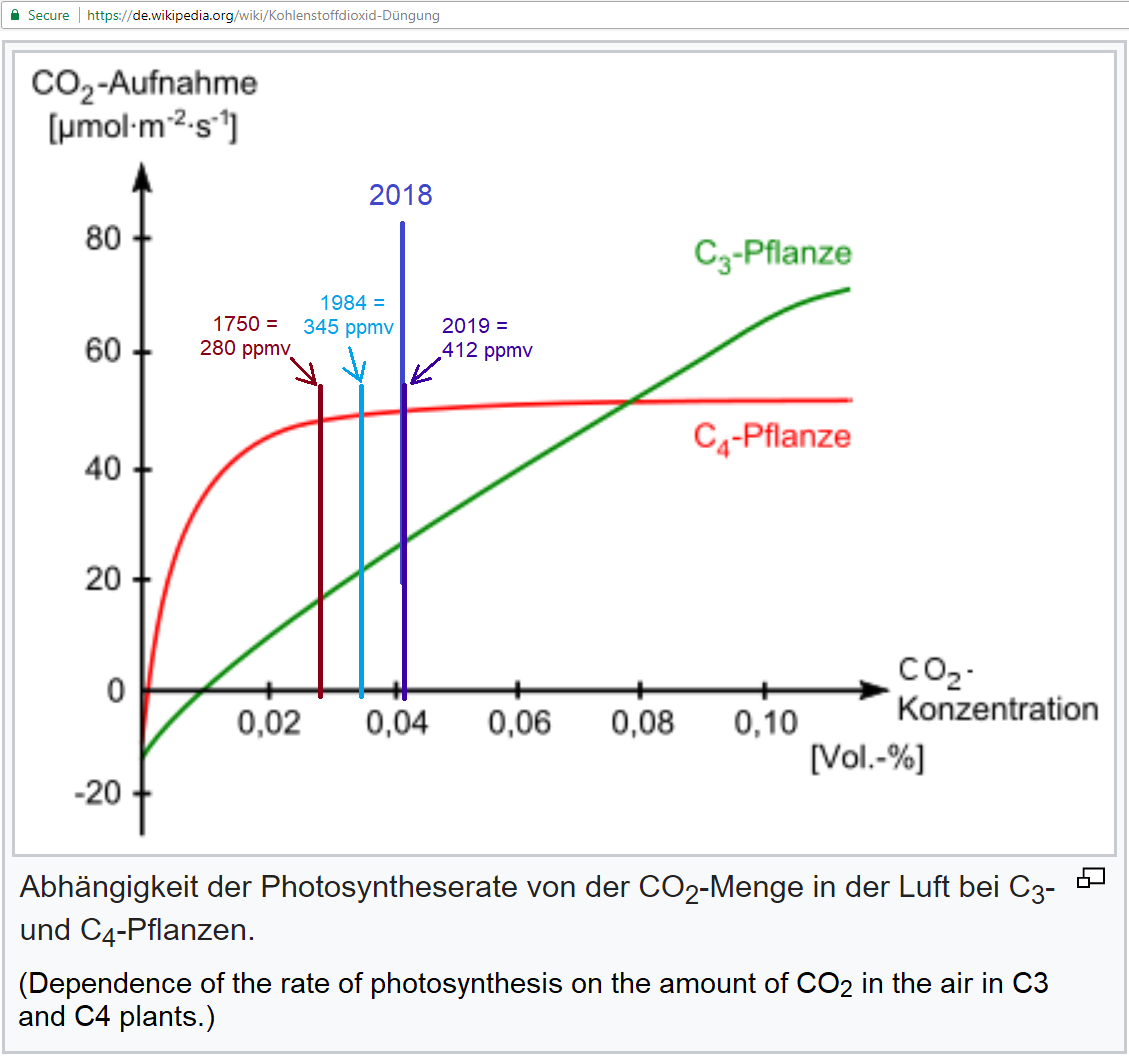
That improvement is one of several major reasons that catastropic famines are fading from living memory.
If you're too young to remember huge, catastrophic famines, count yourself blessed. Through all of human history, until very recently, famine was one of the great scourges of mankind, the "Third Horseman of the Apocalypse." But no more. This is a miracle!
https://ourworldindata.org/famines
Ending famine is a VERY Big Deal, comparable to ending war and disease. Compare:
● Covid-19 killed 0.1% of world population.
● 1918 flu pandemic killed about 2%.
● WWII killed 2.7%.
● The near-global drought and famine of 1876-78 killed about 3.7% of the world population.Eclectic wrote, "other CO2/AGW concomitant effects of increased droughts /floods /heat-waves can be harmful to crop yields in open-field agriculture. [And especially so for the staple crop of maize.]"
Well, let's examine those one at a time.
Heat-waves. Overall, temperature extremes are not worsened by the warming trend. Heat waves are slightly worsened, but by less than cold snaps are mitigated. That's because, thanks to "Arctic amplification," warming is disproportionately at chilly high latitudes, and it is greatest at night and in winter. The tropics warm less, which is nice, because they're warm enough already.
1°C is about the temperature change you get from a 500 foot elevation change. (That's calculated from an average lapse rate of 6.5 °C/km.)
On average, 1°C is similar in effect to a latitude change of about sixty miles, as you can see by looking at an agricultural growing zone map. Here's one, from the Arbor Day Foundation:
From eyeballing the map, you can see that 1°C (1.8°F) = about 50-70 miles latitude change.
James Hansen and his colleagues reported a similar figure: "A warming of 0.5°C... implies typically a poleward shift of isotherms by 50 to 75 km..."
1°C is less than the hysteresis ("dead zone") in your home thermostat, which is the amount that your indoor temperatures go up and down, all day long, without you even noticing.
In the American Midwest, farmers can fully compensate for 1°C of climate change by adjusting planting dates by about six days.
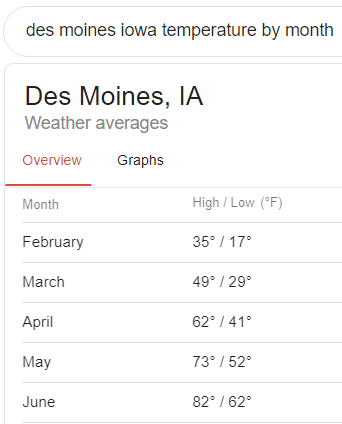
Floods. Theoretically, by accelerating the water cycle, climate change could increase the frequency or severity of floods. But the effect is too slight to be noticeable. AR6 says no change in global flood frequency is detectable:
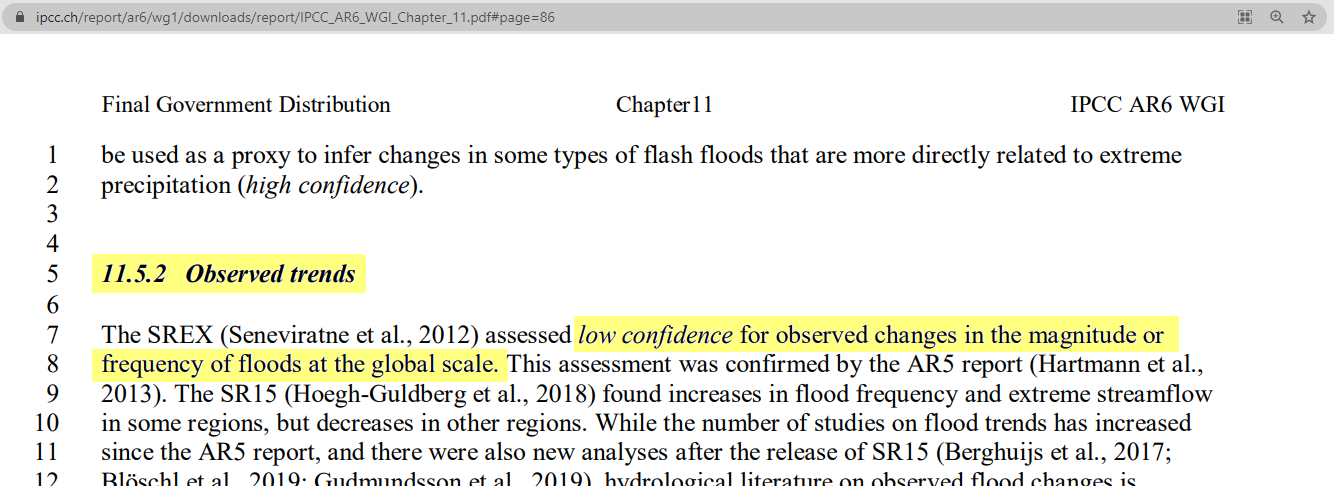
Droughts. Droughts have not worsened. In fact, the global drought trend is slightly down. Here's a study:
Hao et al. (2014). Global integrated drought monitoring and prediction system. Sci Data 1(140001). doi:10.1038/sdata.2014.1
Here's the U.S. drought trend (the bottom/orange side of the graph):
https://www.ncei.noaa.gov/access/monitoring/uspa/wet-dry/0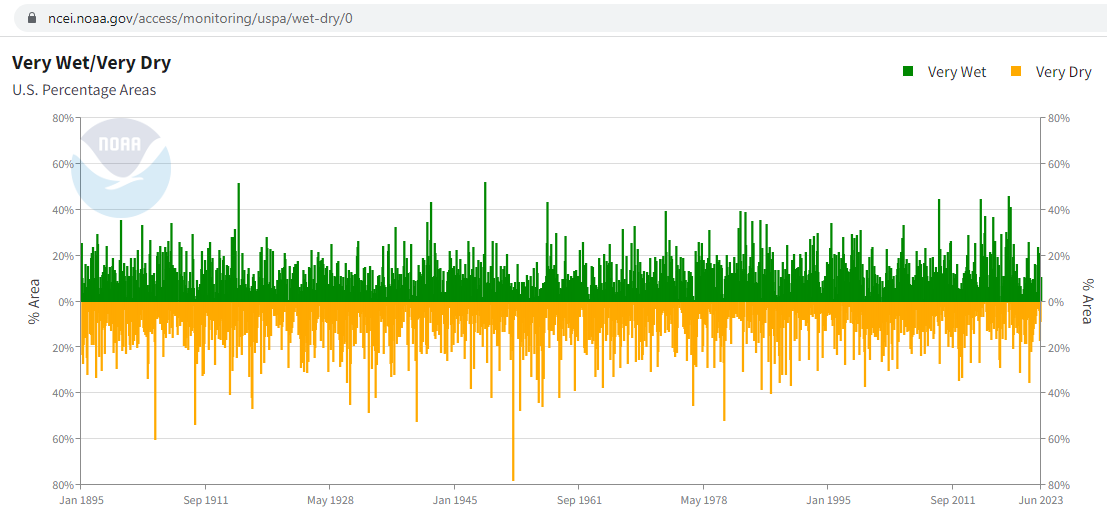
Not only does climate change not worsen droughts, it has long been settled science that eCO2 improves plants' water use efficiency (WUE) and drought resilience, by improving CO2 stomatal conductance relative to transpiration. So eCO2 is especially beneficial in arid regions, and for crops which are under drought stress.
Maize (corn) has been very heavily studied. Even though it is a C4 grass, it benefits greatly from elevated CO2, especially under drought stress. Here's a study (one of many):
Chun et al. (2011). Effect of elevated carbon dioxide and water stress on gas exchange and water use efficiency in corn. Agric For Meteorol 151(3), pp 378-384, ISSN 0168-1923. doi:10.1016/j.agrformet.2010.11.015.
EXCERPT:
"There have been many studies on the interaction of CO2 and water on plant growth. Under elevated CO2, less water is used to produce each unit of dry matter by reducing stomatal conductance."Here's a similar study about wheat:
Fitzgerald GJ, et al. (2016) Elevated atmospheric [CO2] can dramatically increase wheat yields in semi-arid environments and buffer against heat waves. Glob Chang Biol. 22(6):2269-84. doi:10.1111/gcb.13263.
However, I agree with you that putting a monetary value on the benefits of CO2 for crops is difficult. In part that's because the price of food soars when it's in short supply, and plummets when it's plentiful. So, for example, if we were to attribute, say, 15% of current crop yields to CO2 fertilization & CO2 drought mitigation, and value that 15% using current crop prices, we would be underestimating the true value, because absent that 15% boost the prices would have been much higher.
-
Eclectic at 21:58 PM on 13 July 2023SkS Analogy 9 - The greenhouse effect is a stack of blankets
Bobhisey @1 ,
You have completely misunderstood the physics of the interaction of InfraRed radiation and CO2 (and other molecules).
Bob, you are an intelligent guy, and you have been hovering on the edges of the "climate debate" for ages now. And yet you still keep failing to grasp the basics of science in this regard. There must be some sort of mental block going on. Know Thyself !
-
bobhisey at 21:27 PM on 13 July 2023SkS Analogy 9 - The greenhouse effect is a stack of blankets
There is a logical fallacy at the root of this misleading analagy. That is, if some CO2 absorbs some IR, then more CO2 will always absorb more.
But CO2 can only effectively absorb the Earth's IR in one radiation band. That of 14-16 microns wavelength.
1992 NASA data shows that at present CO2 levels, the CO2 absorbs all of the enery in this band. So more CO2 cannot absorb more energy-it is not there.
My analogy. If there is one cup of water in a bowl, and 1 sponge can absorb 1 cup. 1 sponges will not absorb 2 cups-it just isn't there.
NASA Technical Memorandum 103957. Appendix E. This has not been available until very recently. A full discussion can be found in "Carbon Dioxide-Not Guilty". Hisey, 2022. Kindle.
Moderator Response:[BL] There is a Comments Policy here at this web site. Item #3 says:
Comments should avoid excessive repetition.
This is the fourth time you have made the same comment. on various threads. Further attempts will be deleted in their entirety.
Final Warning
Please note that posting comments here at SkS is a privilege, not a right. This privilege can and will be rescinded if the posting individual continues to treat adherence to the Comments Policy as optional, rather than the mandatory condition of participating in this online forum.
Moderating this site is a tiresome chore, particularly when commentators repeatedly submit offensive, off-topic posts or intentionally misleading comments and graphics or simply make things up. We really appreciate people's cooperation in abiding by the Comments Policy, which is largely responsible for the quality of this site.
Finally, please understand that moderation policies are not open for discussion. If you find yourself incapable of abiding by these common set of rules that everyone else observes, then a change of venues is in the offing.Please take the time to review the policy and ensure future comments are in full compliance with it. Thanks for your understanding and compliance in this matter, as no further warnings shall be given.
-
Eclectic at 21:26 PM on 13 July 2023How big is the “carbon fertilization effect”?
Daveburton @22 ~ Please explain more of your first chart [ IPCC's decadal Carbon Flux Comparison 1980-2019 ].
The natural sink flux figures there are indeed broad brush, to be sure ~ but they show a rather steady proportionality to the total carbon emissions. # The land sink shows about 30-35% of total emissions, while the sum of land & ocean remains around 55-60% . It may not be statistically significant ~ but the proportion actually reduces as the emissions increase over the last 3 decades.
In other words, as the decades progress, the natural carbon sink flux in absolute terms rises with the rising emissions ~ but does not show a proportional increase.
The corollary of that is: looking back in time ~ as the atmospheric CO2 level decreases, the size of the natural sink flux decreases also. Daveburton, this directly contradicts your hypothesis of "if emissions were halved ... atmospheric CO2 level would plateau."
[B] Papers such as Zhu et al. 2016 [Nature Climate Change] and the Charles Taylor & Wolfram Schlenker one (not peer-reviewed) you mention above . . . point out the multifactorial complexities in assessing the relevance of greening & browning (of vegetated land) where measured by Leaf Area Index (seen per satellite). Very difficult to come to a substantive conclusion of value ! While the nutritive components of some food crops may reduce slightly as CO2 rises . . . nevertheless, it is (as you state) beyond argument that higher CO2 benefits overall crop yield & plant mass.
However, Daveburton ~ and I presume that this has been pointed out to you many times before ~ the other CO2/AGW concomitant effects of increased droughts /floods /heat-waves can be harmful to crop yields in open-field agriculture. [And especially so for the staple crop of maize.]
-
daveburton at 15:36 PM on 13 July 2023How big is the “carbon fertilization effect”?
Rob wrote elsewhere, "greening is now turning into 'browning.' ... fertilization [has now been] overwhelmed by other effects... In other words, the greening has now stopped," and here, "You were making the claim that natural sinks were removing more of our emissions, and that is not the case by any stretch of the imagination.""
Here's AR6 WG1 Table 5.1, which shows how natural CO2 removals are accelerating:
https://www.ipcc.ch/report/ar6/wg1/downloads/report/IPCC_AR6_WGI_Chapter_05.pdf#page=48Here it is with the relevant bits highlighted:
https://sealevel.info/AR6_WG1_Table_5.1.png
Or, more concisely:
https://sealevel.info/AR6_WG1_Table_5.1_annot1_partial_carbon_flux_comparison_760x398.png
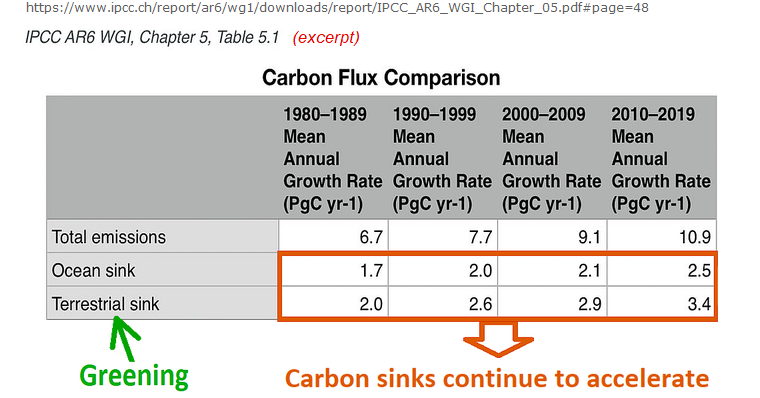
(Note: 1 PgC = 0.46962 ppmv = 3.66419 Gt CO2.)As you can see, as atmospheric CO2 levels have risen, the natural CO2 removal rate has sharply accelerated. (That's a strong negative/stabilizing climate feedback.)
AR6 FAQ 5.1 also shows how both terrestrial and marine carbon sinks have accelerated, here:
https://www.ipcc.ch/report/ar6/wg1/downloads/report/IPCC_AR6_WGI_Chapter05.pdf#page=99Here's the key graph; I added the orange box, to highlight the (small) portion of the graph which supports your contention that, "greening is now turning into 'browning.' ... fertilization [has now been] overwhelmed by other effects... In other words, the greening has now stopped."
https://sealevel.info/AR6_FAQ_5p1_Fig_1b_final2.png
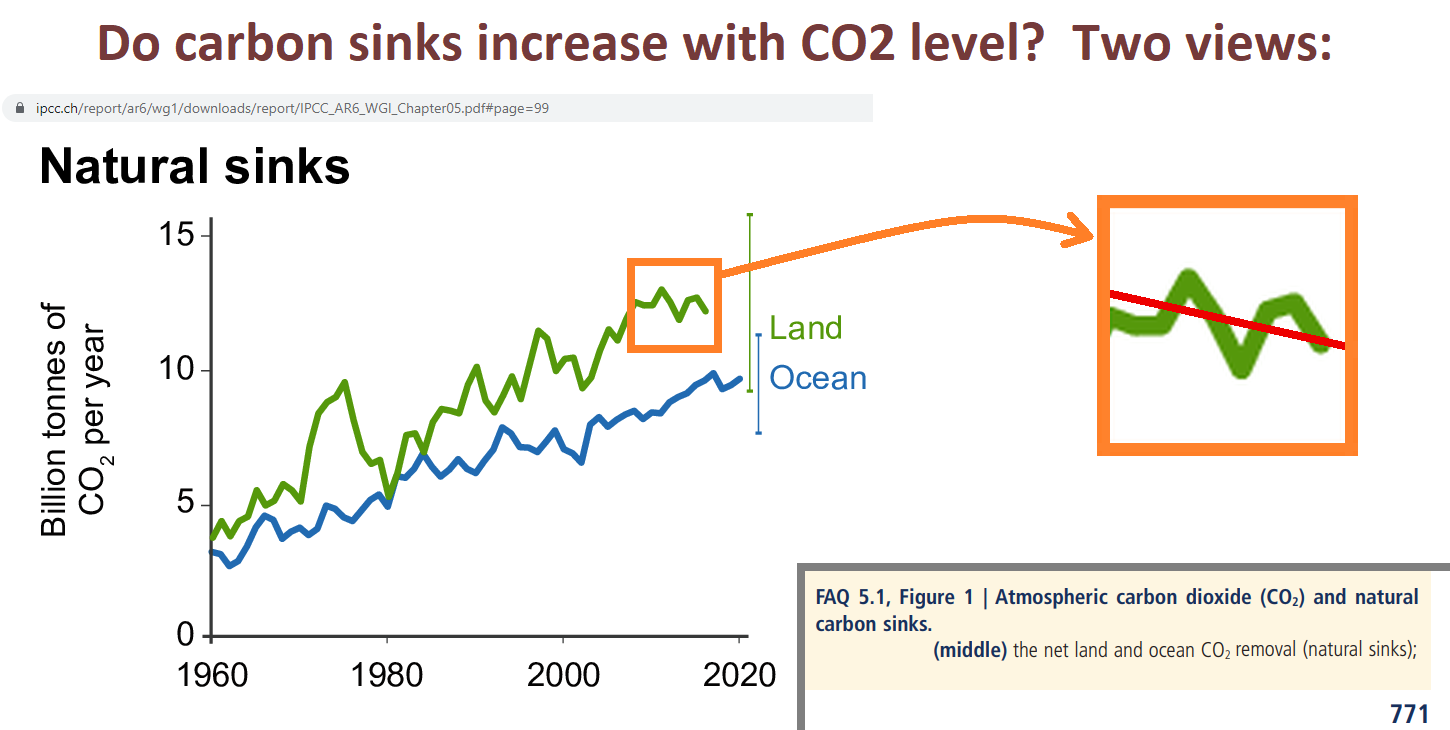
Here's the caption, explicitly saying that natural removal of carbon from the atmosphere is NOT weakening:
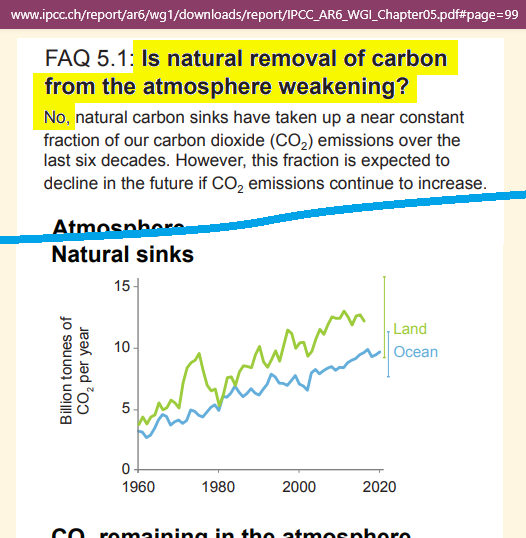
The authors did PREDICT a "decline" in the FUTURE, "if" emissions "continue to increase." But it hasn't happened yet.
What's more, the "decline" which they predicted was NOT for the rate of natural CO2 removals by greening and marine sinks, anyhow. Rather, if you read it carefully, you'll see that that hypothetical decline was predicted for the ratio of natural removals to emissions.
What's more, their prediction is conditional, depending on what happens with future emissions ("if CO2 emissions continue to increase").
Well, predictions are cheap. My prediction is that natural removals of CO2 from the atmosphere will continue to accelerate, for as long as CO2 levels rise.
The "fraction" which they predict might decline, someday, doesn't represent anything physical, anyhow. (It is one minus the equally unphysical "airborne fraction.") Our emission rate is currently about twice the natural removal rate, so if emissions were halved, the removal "fraction" would be 100%, and the atmospheric CO2 level would plateau. If emissions were cut by more than half then the removal "fraction" would be more than 100%, and the CO2 level would be falling.
I wrote elsewhere, "This recent study quantifies the effect for several major crops. Their results are toward the high end, but their qualitative conclusion is consistent with many, many other studies. They reported, "We consistently find a large CO2 fertilization effect: a 1 ppm increase in CO2 equates to a 0.4%, 0.6%, 1% yield increase for corn, soybeans, and wheat, respectively.""
If you recall that mankind has raised the average atmospheric CO2 level by 140 ppmv, you'll recognize that those crop yield improvements are enormous!
Rob replied, "If you actually read more than just the abstract of that study you find this on page 3: 'Complicating matters further, a decline in the global carbon fertilization effect over time has been documented, likely attributable to changes in nutrient and water availability (Wang et al. 2020).'"
Rob, I already addressed Wang et al (2020), but you might not have seen it, because the mods deemed it off-topic and deleted it. Here's what I wrote:
Rob, it's possible that your confusion on the greening/browning point was due to a widely publicized paper, with an unfortunately misleading title:
Wang et al (2020), "Recent global decline of CO2 fertilization effects on vegetation photosynthesis." Science, 11 Dec 2020, Vol 370, Issue 6522, pp. 1295-1300, doi:10.1126/science.abb7772
Many people were misled by it. You can be forgiven for thinking, based on that title, that greening due to CO2 fertilization had peaked, and is now declining.
But that's not what it meant. What it actually meant was that the rate at which plants remove CO2 from the atmosphere has continued to accelerate, but that its recent acceleration was less than expected. (You can't glean that fact from the abstract; would you like me to email you a copy of the paper?)
What's more, if you read the "Comment on" papers responding to Wang, you'll learn that even that conclusion was dubious:
Sang et al (2021), "Comment on 'Recent global decline of CO2 fertilization effects on vegetation photosynthesis'." Science 373, eabg4420. doi:10.1126/science.abg4420
Frankenberg et al (2021), "Comment on 'Recent global decline of CO2 fertilization effects on vegetation photosynthesis'." Science 373, eabg2947. doi:10.1126/science.abg2947
Agronomists have studied every important crop, and they all benefit from elevated CO2, and experiments show that the benefits continue to increase as CO2 levels rise to far above what we could ever hope to reach outdoors. Perhaps surprisingly, even the most important C4 crops, corn (maize) and sugarcane, benefit dramatically from additional CO2. C3 plants (including most crops, and all carbon-sequestering trees) benefit even more.
Rob also quoted the study saying, "While CO2 enrichment experiments have generated important insights into the physiological channels of the fertilization effect and its environmental interactions, they are limited in the extent to which they reflect real-world growing conditions in commercial farms across a large geographic scale."
That's a reference to the well-known fact that Free Air Carbon Enrichment (FACE) studies are less accurate than greenhouse and OTC (open top container) studies, because in FACE studies wind fluctuations unavoidably cause unnaturally rapid variations in CO2 levels. So FACE studies consistently underestimate the benefits of elevated CO2. Here's a paper about that:
Bunce, J.A. (2012). Responses of cotton and wheat photosynthesis and growth to cyclic variation in carbon dioxide concentration. Photosynthetica 50, 395–400. doi:10.1007/s11099-012-0041-7
The issue is also explained by Prof. George Hendrey, here:
"Plant responses to CO2 enrichment: Much of what is known about global ecosystem responses to future increases in atmospheric CO2 has been gained through Free-Air CO2 Enrichment (FACE) experiments of my design. All FACE experiments exhibit rapid variations in CO2 concentrations on the order of seconds to minutes. I have shown that long-term photosynthesis can be reduced as a consequence of this variability. Because of this, all FACE experiments tend to underestimate ecosystem net primary production (NPP) associated with a presumed increased concentration of CO2."
Rob wrote, "It does seem that you're claiming CO2 uptake falls with increasing temperature.""
That is correct for uptake by water. Or, rather, it would be correct, were it not for the fact that the small reduction in CO2 uptake due to the temperature dependence of Henry's Law is dwarfed by the large increase in CO2 uptake due to the increase in pCO2.
Rob wrote, "But it's unclear to me how you think this plays into the conclusion that CO2 levels would 'quickly normalize' over the course of 35 years" and also, "You also claimed CO2 concentrations would quickly come down (normalize) once we stop emitting it. This is also not correct unless you're using 'normalize' to mean 'stabilize at a new higher level'."
Perhaps you've confused me with someone else. I said nothing about CO2 levels "normalizing."
I did point out that the effective half-life for additional CO2 which we add to the atmosphere is only about 35 years. I wrote:
The commonly heard claim that "the change in CO2 concentration will persist for centuries and millennia to come" is based on the "long tail" of a hypothetical CO2 concentration decay curve, for a scenario in which anthropogenic CO2 emissions go to zero, CO2 level drops toward 300 ppmv, and carbon begins slowly migrating back out of the deep oceans and terrestrial biosphere into the atmosphere. It's true in the sense that if CO2 emissions were to cease, it would be millennia before the CO2 level would drop below 300 ppmv. But the first half-life for the modeled CO2 level decay curve is only about 35 years, corresponding to an e-folding "adjustment time" of about fifty years. That's the "effective atmospheric lifetime" of our current CO2 emissions.
Rob wrote, "Dave... The fundamental fact that you disputed is that oceans take up about half of our emissions."
That reflects two points of confusion, Rob.
In the first place, our emissions are currently around 11 PgC/year (per the GCP). The oceans remove CO2 from the atmosphere at a current rate of a little over 2.5 PgC/year. That's only about 1/4 of the rate of our emissions, not half.
More fundamentally, the oceans are not removing some fixed fraction of our emissions. None of the natural CO2 removal processes do. All of them remove CO2 from the bulk atmosphere, at rates which largely depend on the atmospheric CO2 concentration, not on our emission rate. If we halved our CO2 emission rate, natural CO2 removals would continue at their current rate.
Because human CO2 emissions are currently faster than natural CO2 removals, we've increased the atmospheric CO2 level by about 50% (140 ppmv), but we've increased the amount of carbon in the oceans by less than 0.5%, as you can see in AR5 WG1 Fig. 6-1.
Sorry, this got kind of long. I hope I addressed all your concerns.
-
Rob Honeycutt at 11:23 AM on 13 July 2023How big is the “carbon fertilization effect”?
Dave... The fundamental fact that you disputed is that oceans take up about half of our emissions. It's a fact that has been clearly stated in the citations both of us have presented.
You also claimed CO2 concentrations would quickly come down (normalize) once we stop emitting it. This is also not correct unless you're using "normalize" to mean "stabilize at a new higher level". But they're not going to stabilize back to 300ppm.
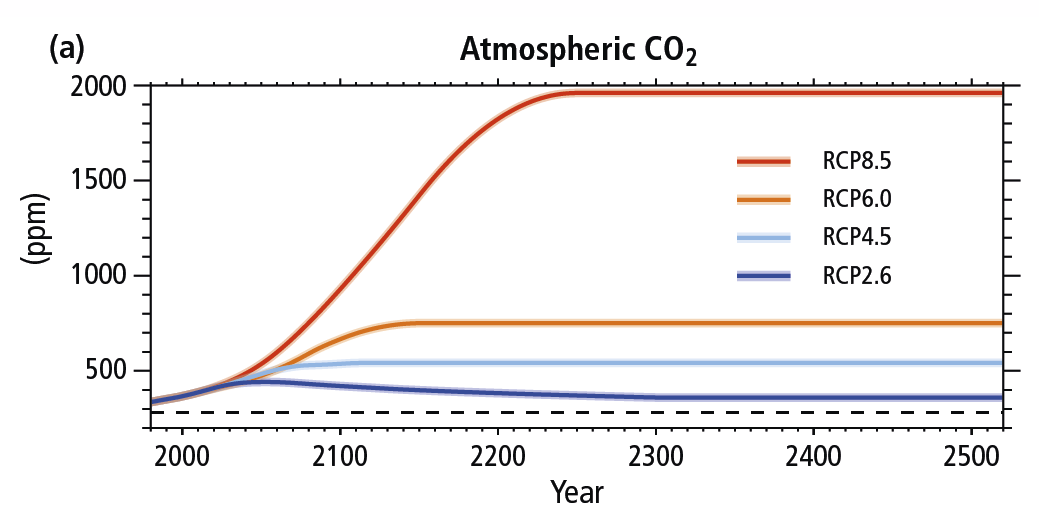
-
daveburton at 08:56 AM on 13 July 2023How big is the “carbon fertilization effect”?
Rob, in answer to your first question, Bob is correct: they use different units.
Both the graph and the "plug in suitable values" calculation (above) are for freshwater, but that hardly matters. CO2 is noticeably less soluble in saltwater, but the effect of temperature on CO2 solubility is nearly identical. Here's the same calculation with salinity 35 (typical seawater), for a 1° temperature increase (from 288K to 289K):
Bob is also correct that ocean chemistry is more complicated than that, in part because most of the dissolved CO2 immediately dissosiates into various ions. Here's a good resource on ocean chemistry:
http://www.molecularmodels.eu/cap11.pdfWhat's more, in the oceans, biology generally trumps chemistry, and that is certainly true for CO2 uptake. Some people think that the capacity of the oceans to take up CO2 is limited to surface water by ocean stratification. But that's incorrect, beause the "biological carbon pump" rapidly moves CO2 from surface waters into the ocean depths, in the form of "marine snow."
The higher CO2 levels go, the faster that "pump" works. Here's a paper about it:
https://www.science.org/doi/reader/10.1126/science.aaa8026Once carbon has migrated from the ocean surface to the depths, most of it remains sequestered for a very long time. Some of it settles on the ocean floor, but even dissolved carbon is sequestered for a long time. For instance, it is estimated that the AMOC takes about 1000 years to move carbon-rich water from high latitudes to the tropics, where it can reemerge. That is obviously far longer than the anthropogenic CO2 emission spike will last.
Due to the temperature dependence of Henry's Law, a 1°C increase in temperature slows CO2 uptake by the oceans by about 3%. That's a slight positive feedback: more CO2 in the air increases water temperatures, which slows ocean uptake of CO2. But it is very minor, because a 50% (140 ppmv) rise in atmospheric CO2 concentration accelerates CO2 uptake by the oceans by 50%, which obviously dwarfs 3%. That's the main reason that ocean uptake of CO2 continues to accelerate despite the temperature dependence of Hanry's Law.
-
Rob Honeycutt at 04:47 AM on 13 July 2023How big is the “carbon fertilization effect”?
Dave... Going back to read what you previously wrote. (sigh)
You stated, "Some people point to that little orange box and say that greening has ceased."
No, I don't think anyone is pointing to your little orange box, nor are they using the original graph to make such a determination. This was a predicted result long before that graph existed. The determination of whether it's occurring is based on other observations related, I believe, primarily related to ongoing deforestation, changes in land use, etc.
You also stated, "This recent study quantifies the effect for several major crops. Their results are toward the high end...[etc]"
If you actually read more than just the abstract of that study you find this on page 3:
Complicating matters further, a decline in the global carbon fertilization effect over time has been documented, likely attributable to changes in nutrient and water availability (Wang et al. 2020). While CO2 enrichment experiments have generated important insights into the physiological channels of the fertilization effect and its environmental interactions, they are limited in the extent to which they reflect real-world growing conditions in commercial farms across a large geographic scale.
That directly confirms for you what I've been saying. (You really do need to read the full papers.)
It does seem that you're claiming CO2 uptake falls with increasing temperature. But it's unclear to me how you think this plays into the conclusion that CO2 levels would "quickly normalize" over the course of 35 years. Research tells us that's not the case.
Persistence of climate changes due to a range of greenhouse gases

-
Bob Loblaw at 04:13 AM on 13 July 2023How big is the “carbon fertilization effect”?
Rob @ 16:
daveburton's graph is using different units from the Pro-ocean one - g/100g, rather than mole/kg-atm.
Before going down this Henry's Law rabbit hole, note that the uptake of CO2 in water is not solely related to the solubility of CO2 in water. The CO2 rapidly dissociates into ions that combine with the calcium carbonate present in sea water.

There is an excellent series here on ocean acidification:
OA Not OK part zero lists all the individual posts.
Part 15 mentions how solubility of CO2 depends on the presence of other ions.
...but there are many parts to the series. Each individual part is small, so going through them is worthwhile.
-
Rob Honeycutt at 01:41 AM on 13 July 2023How big is the “carbon fertilization effect”?
Dave... Perhaps also think about what this chart represents. It's saying the solubility of CO2 falls as temperature increases. That means when temperature rises more CO2 remains in the atmosphere leading to more warming.
I believe this is the same effect that amplifies warming from orbital patterns to produce glacial-interglacial events.
If I'm correctly interpreting what you're claiming, it seems you're saying that warming oceans will take up more CO2, which would be inverse to the actual effect of CO2 solubility.
-
Rob Honeycutt at 01:21 AM on 13 July 2023How big is the “carbon fertilization effect”?
Before we dig into your equation, can I ask why your Y-axis is an order of magnitude greater than the Pro-ocean graph?
-
daveburton at 00:59 AM on 13 July 2023How big is the “carbon fertilization effect”?
I wrote elsewhere, "Due to the temperature dependence of Henry's Law, a 1°C increase in temperature slows CO2 uptake by the oceans by about 3%."
In reply, Rob asked, "Where do you come up with this 3% figure?"
From Weiss (1974), an approximate relationship is (as summarized by Pro-Oceanus):
The equilibrated ratio of partial pressure to dissolved concentration is governed by solubility:
pCO2 = Kₒ [CO2 (aq)]
where pCO2 is the partial pressure of CO2 in the gas phase, Kₒ is a solubility coefficient, and CO2 (aq) is the concentration of CO2 dissolved in the water.
The solubility of CO2 in water is a function of both the temperature and the salinity of the water, one relationship from Weiss (1974):
ln (Kₒ) = -60.2409 + 93.4517(100/T) + 23.3585(ln(T/100)) + S(0.023517-0.023656(T/100)+0.0047036(T/100)²)
where the solubility coefficient (Kₒ) has the units of mol kg⁻¹ atm⁻¹, temperature (T) is Kelvin, and salinity (S) is in parts per thousand (approximately equal to PSU).
Note that for non-saline waters, the second term of the equation becomes zero, leading to
ln (Kₒ) = -60.2409+93.4517(100/T)+23.3585 ln (T/100)
To get the "3%" figure, you can plug in suitable values, or you can look at a graph, like this one:
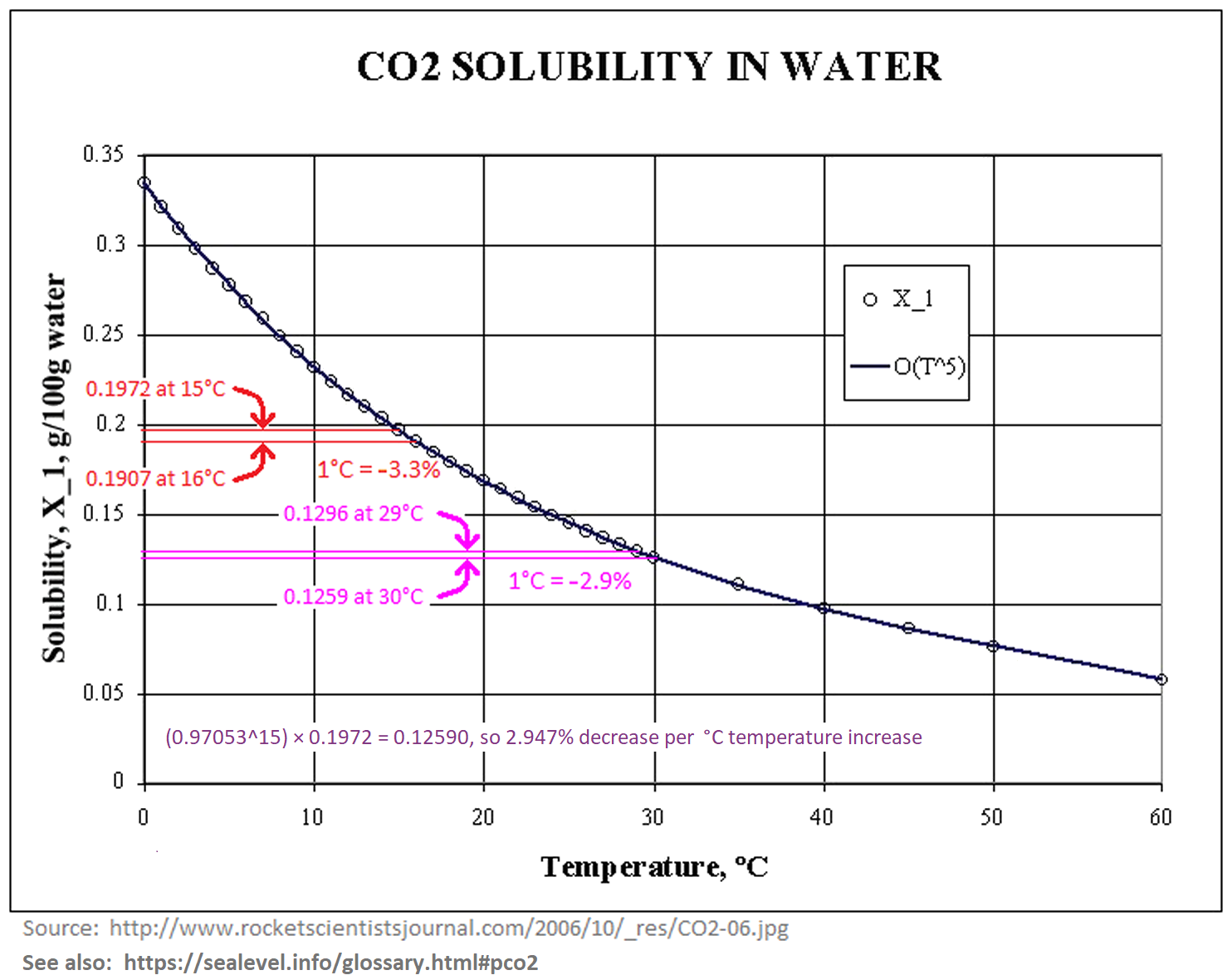
-
daveburton at 22:26 PM on 12 July 2023Hansen predicted the West Side Highway would be underwater
One of the "BL"s here wrote, "[Major snip] Response: [BL] All of this is off-topic for this thread."
And that is why SkS is not on my list of recommended climate change blogs.
You left Rob Honeycutt's accusations, but deleted my response to them.
You left Bob Loblaw's speculation about my identity, but deleted my response.
If this is not the right thread for the replies to those comments, then how can it be the right thread for them to make those comments, BL?
Moderator Response:[BL] Moderation complaints snipped.
Please note that posting comments here at SkS is a privilege, not a right. This privilege can and will be rescinded if the posting individual continues to treat adherence to the Comments Policy as optional, rather than the mandatory condition of participating in this online forum.
Moderating this site is a tiresome chore, particularly when commentators repeatedly submit offensive or off-topic posts. We really appreciate people's cooperation in abiding by the Comments Policy, which is largely responsible for the quality of this site.
Finally, please understand that moderation policies are not open for discussion. If you find yourself incapable of abiding by these common set of rules that everyone else observes, then a change of venues is in the offing.Please take the time to review the policy and ensure future comments are in full compliance with it. Thanks for your understanding and compliance in this matter.
-
daveburton at 21:53 PM on 12 July 2023Hansen predicted the West Side Highway would be underwater
Bob Ludlow wrote
[Contents snipped]
"You have no objective criteria to declare that The Battery and Honolulu are "the best" at representing anything other than local effects..."
The Battery has 1825 months of sea-level measurements. No other NOAA Atlantic site has that much. Only San Francisco has more, but it has only 1404 months of measurements since the 1906 earthquake. The downside to The Battery's measurement record is its high (atypical) rate of subsidence, which roughly doubles the local ("relative") sea-level trend there.
There are some European sites with longer, better Atlantic / North Sea / Baltic measurement records, and Australia has an excellent Pacific measurement record, but there are substantial delays getting data for those locations. My sealevel.info stie pulls data from NOAA frequently, so it's much more up-to-date.
Some of the European sites, have recorded a slight acceleration; it was most noticeable at Brest, which saw a 0.0 mm/year trend in the19th century, but a 1.6 mm/year trend since then, though there are substantial gaps in ther record.
Several German sites have particularly excellent measurement records; here's one of them:
In the Pacific, Honolulu has 1421 months (>118 years) of continuous sea-level measurements, without even a single missing month. Just as importantly, Honolulu is a near-ideal measurement site, near the middle of the world's largest ocean, on an "old" island with near-zero vertical land motion, small tides, and (unlike most places!) almost no seasonal cycle. What's more, its mid-Pacific location is near the pivot point of the east-west Pacific "teeter-totter," so it is little affected by ENSO "slosh." That is, El Niño and La Niña don’t affect sea-level there much at all. It really is a superb dataset.
Bob continued, "Just because they have long records does not mean that they accurately reflect regional or global trends."
That's true. As I've mentioned, NYC's sea-level trend is atypical, because of the high rate of subsidence there.
However, if subsidence / uplift are due to very long term processes, like PGR, there's reason to hope that they are fairly consistent over the duration of the measurement record. In that case, even if the linear trend is greatly affected by uplift or subsidence, the acceleration won't be. (Of course, that doesn't work in places, like Manila, where changing local factors, like groundwater pumping, cause varying subsidence.)So it should not surprise you that, even though The Battery and Honolulu have seen quite different linear trends over the last century, the measured acceleration in both places is very similar (negligible).
Bob wrote, "You are clearly picking locations to try to tell the story you want to tell."
That's a false accusation. You just find the data surprising, so you make baseless accusations, without evidence. That is not conducive to constructive dialogue, nor to learning.
If you think I chose unrepresentative sites, or sites with inferior quality measurement data, then YOU tell me what sites YOU think are better, and why.
Bob wrote, "As for your quadratic fits: it has been pointed out to you over the past 10 years that quadratic fits mean nothing when the underlying data does not resemble a quadratic relationship."
Nobody competent makes that claim in the context of sea-level analysis.
If there were a step-change in some climate system input, then you could look for a step-acceleration as a consequence. But there's been nothing like that. The radiative forcing trend from CO2 has been very gradual, and strikingly linear (just barely more than linear) for the last forty years. It's been quite gradual for much longer than that.
Quadratic regression is the cannonical way of detecting gradual acceleration. It's how Church & White did it, and how every competent sea-level analyst since then has done it. When Hogarth reported that, "sea level acceleration from extended tide gauge data converges on 0.01 mm/yr²," that's what he was talking about.
Moderator Response:[BL} I see that reading comprehension is not one of your strong points.
Assuming that "Bob Ludlow" is supposed to mean "Bob Loblaw", you will also note that I said:
This discussion is also getting off topic for this rebuttal of Hansen's statement. If you want to continue to discuss sea level, there are better places here at SkS. Here are two SkS posts that provide some of the material from Tamino that I referred to earlier.
The next off-topic post be be deleted in its entirety.
-
bobhisey at 21:30 PM on 12 July 2023CO2 effect is saturated
My arguement is not against global warming, but in falsely ascribing it to CO2.
A full discussion can be seen in "Carbon Dioxide - Not Guilty" on kindle for 99c.
Moderator Response:[BL] repetition of previous points made on other threads snipped.
You have been down this road before, (here, and here) and you have been warned before.
Please note that posting comments here at SkS is a privilege, not a right. This privilege can be rescinded if the posting individual treats adherence to the Comments Policy as optional, rather than the mandatory condition of participating in this online forum.
Please take the time to review the policy and ensure future comments are in full compliance with it. Thanks for your understanding and compliance in this matter.
-
Philippe Chantreau at 08:02 AM on 12 July 2023Hansen predicted the West Side Highway would be underwater
I have had many other things to do, certainly more important. I have a full time job and a life. I will respond in time. Perusing through the references presented, I was not very impressed.
-
Doug Bostrom at 06:41 AM on 12 July 2023Skeptical Science New Research for Week #27 2023
Apologies for belated reply regarding the above item. This could be due to a local software fault or a transient problem with Unpaywall. As with "my bank statement balance is wrong," probably the former.
Open access articles are identified via API calls to Unpaywall; likely we have local problem with interpreting UP's response. A clue is that the "open access" link for this paper doesn't have a url behind it, meaning that UP did not supply such because it doesn't exist.
Thank you for the heads up and triggering debugging. :-)
-
One Planet Only Forever at 06:19 AM on 12 July 20237 TV meteorologists discuss their coverage of climate change and weather
An update regarding a couple of the passionate helpful meteorologists covered in this article:
- Eric Sorenson won his 2022 run to be a House of Congress representative for Illinois. (Eric Sorenson's Congress.gov webpage)
- Chris Gloninger has quit his TV job due to the threats he received. But he has moved to a potentially more 'annoying to the science denial troop' role with Woods Hole Group. (USA Today "An Iowa meteorologist's climate change coverage led to a death threat. He's now resigning.")
Nasty 'learning resistant people' will always be around. But it is very important, and very challenging, to keep on disappointing them no matter how angry they get ... as long as others are also being communicated to and can see how harmfully incorrect the 'learning resistant people', and their preferred type of leaders, are.
-
Rob Honeycutt at 11:17 AM on 11 July 2023How big is the “carbon fertilization effect”?
Dave... Your reference to the inset on FAQ 5.1 is comical at best.
It states exactly what I'm telling you, as did the other bits I posted.
FAQ 5.1: Is natural removal of carbon
from the atmosphere weakening?
No, natural carbon sinks have taken up a near constant fraction of our carbon dioxide (CO2) emissions over the last six decades.You were making the claim that natural sinks were removing more of our emissions, and that is not the case by any stretch of the imagination. And the caption you posted goes on to say...
However, this fraction is expected to decline in the future if CO2 emissions continue to increase.
How can you not understand this? Take note that AR6, though it's the most current IPCC report, came out nearly two years ago, and the report is relying on data and research that was completed well before even that.
The most recent papers are saying that, yes, that CO2 fertilization effect is now waning.
Tropical Forests’ Carbon Sink Is Rapidly Weakening – Crucial for Stabilizing Earth’s Climate
Once again, in your own citation the language is clear.
FAQ 5.1 | Is the Natural Removal of Carbon From the Atmosphere Weakening?
For decades, about half of the carbon dioxide (CO2) that human activities have emitted to the atmosphere has been taken up by natural carbon sinks in vegetation, soils and oceans. These natural sinks of CO2 have thus roughly halved the rate at which atmospheric CO2 concentrations have increased, and therefore slowed down global warming. However, observations show that the processes underlying this uptake are beginning to respond to increasing CO2 in the atmosphere and climate change in a way that will weaken nature’s capacity to take up CO2 in the future. Understanding of the magnitude of this change is essential for projecting how the climate system will respond to future emissions and emissions reduction efforts.The "observations show" means they are already seeing this happening, and that is based on research that's at least half a decade old.
-
Rob Honeycutt at 10:50 AM on 11 July 2023Hansen predicted the West Side Highway would be underwater
Dave... Some abbreviate response is posted on THIS thread. Please go there if you wish to further discuss CO2 fertilization.
-
daveburton at 06:58 AM on 11 July 2023Hansen predicted the West Side Highway would be underwater
Philippe Chantreau wrote, "I will respond to Dave Burton on the CO2 fertilization thread on the part of this latest post regarding that subject."
Will you please provide a link to your comment to me, Philippe?
[Major snip]
Rob Honeycutt wrote, "1) That is not an image that appears in AR6, not with the added orange box. Thus you're co-opting their work to infer conclusions they do not make."
That's incorrect.
Since we're onto the next page of comments now, here's the image again:
https://sealevel.info/AR6_FAQ_5p1_Fig_1b_final2.png
If you enlarge it you can see, in fine print, the URL that will take you to where you can find it in chapter 5 of AR6:
https://www.ipcc.ch/report/ar6/wg1/downloads/report/IPCC_AR6_WGI_Chapter05.pdf#page=99I added the orange box to highlight the (small) part of the image which supports your contention that, "greening is now turning into 'browning.' ... fertilization [has now been] overwhelmed by other effects... In other words, the greening has now stopped."
AR6 directly contradicts your contention, Rob. In fact, it does so in the caption on that very figure:
They could not have been clearer in stating that natural removal of carbon from the atmosphere is NOT weakening.
The authors did PREDICT a "decline" in the FUTURE, "if" emissions "continue to increase." But that hasn't happened yet, and the "decline" which they predicted was NOT for the rate of natural CO2 removals by greening and marine sinks, anyhow. Rather, that hypothetical decline was predicted for the ratio of natural removals to emissions, and their prediction is conditional, depending on what happens with future emissions ("if CO2 emissions continue to increase").
Well, predictions are cheap. My prediction is that natural removals of CO2 from the atmosphere will continue to accelerate, for as long as CO2 levels rise.
The "fraction" which they predict might decline, someday, doesn't represent anything physical, anyhow. (It is one minus the equally unphysical "airborne fraction.") Our emission rate is currently about twice the natural removal rate, so if emissions were halved, the removal "fraction" would be 100%, and the atmospheric CO2 level would plateau. If emissions were cut by more than half then the removal "fraction" would be more than 100%, and the CO2 level would be falling.
Rob, it's possible that your confusion on the greening/browning point was due to a widely publicized paper, with an unfortunately misleading title:
Wang et al (2020), "Recent global decline of CO2 fertilization effects on vegetation photosynthesis." Science, 11 Dec 2020, Vol 370, Issue 6522, pp. 1295-1300, doi:10.1126/science.abb7772
Many people were misled by it. You can be forgiven for thinking, based on that title, that greening due to CO2 fertilization had peaked, and is now declining.
But that's not what it meant. What it actually meant was that the rate at which plants remove CO2 from the atmosphere has continued to accelerate, but that its recent acceleration was less than expected. (You can't glean that fact from the abstract; would you like me to email you a copy of the paper?)
What's more, if you read the "Comment on" papers responding to Wang, you'll learn that even that conclusion was very dubious:
Sang et al (2021), "Comment on 'Recent global decline of CO2 fertilization effects on vegetation photosynthesis'." Science 373, eabg4420. doi:10.1126/science.abg4420
Frankenberg et al (2021), "Comment on 'Recent global decline of CO2 fertilization effects on vegetation photosynthesis'." Science 373, eabg2947. doi:10.1126/science.abg2947
Agronomists have studied every important crop, and they all benefit from elevated CO2, and experiments show that the benefits continue to increase as CO2 levels rise to far above what we could ever hope to reach outdoors. Perhaps surprisingly, even the most important C4 crops, corn (maize) and sugarcane, benefit dramatically from additional CO2. C3 plants (including most crops, and all carbon-sequestering trees) benefit even more.
Bob Loblaw wrote, "...I have no way of knowing whether our daveburton is the same Dave Burton seen in the discussions at Tamino's... The other Dave Burton's name shows up quite a few times, although he does not comment."
Yes, I'm the Dave Burton who Tamino intermittently criticizes. Unfortunately, when I try to comment on his blog, he nearly always deletes my comments, so I stopped trying. Suffice to say, if you like being misled, you should enjoy his blog. (Example.)
Moderator Response:[BL] All of this is off-topic for this thread.
Use the search function to find appropriate threads. You have already been pointed to several options.
-
BaerbelW at 17:47 PM on 9 July 2023There's no empirical evidence
Please note: the basic version of this rebuttal has been updated on July 9, 2023 and now includes an "at a glance“ section at the top. To learn more about these updates and how you can help with evaluating their effectiveness, please check out the accompanying blog post @ https://sks.to/at-a-glance
Thanks - the Skeptical Science Team.
-
Bob Loblaw at 05:54 AM on 8 July 2023Skeptical Science New Research for Week #27 2023
I get only "Access through your institution" and "Buy or subscribe" options, too.
-
wilddouglascounty at 22:59 PM on 7 July 2023Skeptical Science New Research for Week #27 2023
Thanks for this ongoing treasure-trove of information sources: I'm amazed that you can maintain this! I just scratch the surface of your list, but noticed that one article:
Expanding range and role change, Armarego-Marriott, Nature Climate Change 10.1038/s41558-023-01675-8
...is listed as Open Access, but when I open the link, it's not. Thought you might want to correct the designation.
-
Bob Loblaw at 22:34 PM on 7 July 2023Hansen predicted the West Side Highway would be underwater
daveburton @ 29:
You seem to be under some serious delusions as to what the words "best", and "accurate" really mean.
You have no objective criteria to declare that The Battery and Honolulu are "the best" at representing anything other than local effects. Just because they have long records does not mean that they accurately reflect regional or global trends. You also state:
Beware of "global" sea-level analyses which use varying mixes of measurement locations. As you can see from the striking difference between Oahu and New York, sea-level trends vary considerably from one location to another.
So, you admit that single locations do not provide global trends - yet you seem to be arguing that the "best" way to get global trends is to ignore most of the other data.
You are clearly picking locations to try to tell the story you want to tell. That is not "accurate".
As for your quadratic fits: it has been pointed out to you over the past 10 years that quadratic fits mean nothing when the underlying data does not resemble a quadratic relationship. It does not matter if you "accurately" calculated the quadratic fit when the underlying physics says "not quadratic".
This discussion is also getting off topic for this rebuttal of Hansen's statement. If you want to continue to discuss sea level, there are better places here at SkS. Here are two SkS posts that provide some of the material from Tamino that I referred to earlier.
-
michael sweet at 21:19 PM on 7 July 2023Hansen predicted the West Side Highway would be underwater
DaveBurton:
You are wastiing our time here with your obvious, deliberately incorrect graphs. I note that Tamino specifically addressed your deliberate mistakes as long as a decade ago. You have been wrong for over a decade and you are not informed enough to realize it. You have no excuse for your false claims. Neutral observers wonder why you persist in your obviously false claims for so long.
No-one here will give your garbage a second consideration. You will not convince anyone with your absurd claims. You need to go back to WUWT where they do not care about being lied to.
Every scientist who studiies sea level rise states that sea level rise has accelerated substantially. When you are alone claiming something and everyone who studies the topic professionally states that you are wrong you need to realize that you are not Galileo, you are simply wrong. Look at the pictures of fish in the streets all over the world.
You should go away. You contaminate a scientific site with pretend analysis.
Moderator Response:[BL] Please tone down the accusations a bit.
-
Rob Honeycutt at 11:11 AM on 7 July 2023Hansen predicted the West Side Highway would be underwater
Dave @29... Here you're playing the classic science denier game of cherry picking facts that support the conclusion you prefer. Your graphs are technically correct but intentionally misleading because you're using them outside of the full context of the issue at hand.
If, on the absurd chance, you actually believe what you're presenting is compelling evidence then it is encumbent upon you to publish your findings in a legitimate science journal and convince a panel of experts that your findings are significant.
Given you've been doing this for something over a decade now I would have expected your position to become more substantive and nuanced. But it's not. You're regurgitating the same junk you've been posting all over the internet this entire time.
This leads me to believe you're not genuinely interested in facts or science. You're merely promoting an ideological position and you think this is an interesting way to do that.
Once again, this is not ad hom. Lots of people do exactly what you're doing and they (and you) have every right to do so. All any of us are doing is pointing out how weak your position is.
-
Eclectic at 09:10 AM on 7 July 2023Hansen predicted the West Side Highway would be underwater
Indeed, Daveburton, the sea level is a complex subject. I applaud the detailed work you have done on some aspects of it.
Nevertheless, Dave, you have taken a relatively short-term look at some trees ~ while entirely failing to look at the forest. And failing to take a commonsense look at the underlying physics : the causes of long-term changes.
I am fairly sure you are not the Flat-Earth Scientist who completely discounts the role of CO2 in climate & consequent sea level changes (despite you consciously /subconsciously "trailing your coat" at the start of post #29 ).
My worry (for you) is that you have been "captured" by Motivated Reasoning . . . and that for a number of years now, you have not climbed out of the rabbit-hole.
So . . . good luck for self-examining your inner emotions & motivations. A scientific thinker must rise above his inner bias.
As OnePlanet says, it is the half-truths which are the danger [to one's own self, especially].
-
daveburton at 07:21 AM on 7 July 2023Hansen predicted the West Side Highway would be underwater
Michael wrote, "the last time Carbon dioxide was over 400 ppm the sea level was more than 20 meters higher than current sea level."
Yes, many things were different 4.5 million years ago. They weren't all caused by CO2.
For example, the highest-quality Pacific sea-level measurement record is from Honolulu, on Oahu. But it would be difficult to say anything meaningful about how sea-level there has changed since CO2 levels were last this high, because Oahu (and the Big Island) didn't exist 4 million years ago!
Michael wrote, "Your sea level graphs are obviously flawed."I guarantee that they are not flawed.
They are accurate plots of sea-level measurements at those two sites, which are the best long NOAA Atlantic sea-level measurement record (The Battery, NYC), and the best long NOAA Pacific sea-level measurement record (Honolulu, HI). The linear and quadratic regressions are accurately calculated from the most recent 100 years of data at each site, shown with deep blue traces. Earlier data (not included in the regressions) is shown in light blue.
If you click the links, you can adjust the measurement periods over which the regressions are calculated, and see the effect of those adjustments. You can also smooth the plots, and choose whether to plot linear and/or quadratic fits, as well as confidence and/or prediction intervals. At the top of each graph you'll also find links to the corresponding NOAA and PSMSL web pages for those sites. You can also do the same analyses for other NOAA measurement sites, and for over 1000 sites with data available from PSMSL (though the PSMSL data aren't as up-to-date as the NOAA data).
Michael wrote, "you have cherry picked two single locations to do your calculations without justifying your choice."They aren't "cherry-picked," I told you why I chose them: they are "the best long U.S. Atlantic and Pacific sea-level measurement records, respectively."
The analysis period of 100 years is arbitrary, of course, but if you click the links which I provided you can easily change it:
https://sealevel.info/MSL_graph.php?id=Battery&c_date=1923/6-2023/5
https://sealevel.info/MSL_graph.php?id=Honolulu&c_date=1923/6-2023/5I also reported the conclusion of a comprehensive study: "Hogarth studied many long measurement records, and concluded, 'Sea level acceleration from extended tide gauge data converges on 0.01 mm/yr²'" (That's negligible, BTW.)
Beware of "global" sea-level analyses which use varying mixes of measurement locations. As you can see from the striking difference between Oahu and New York, sea-level trends vary considerably from one location to another. So if you use a different mix of measurement locations for the left and right ends of a plot, you can easily create the illusion of a sharp acceleration or deceleration which is not evident in the individual measurement records.
Also, beware of the fact that there are also regional effects, in some places. For example, ENSO causes changes in low-latitude easterly Pacific trade winds. During El Niños easterly Pacific equatorial trade winds diminish, so the Pacific ocean sloshes east, raising sea-level in the eastern Pacific, and lowering it in the western Pacific. This is very striking when you compare the sea-level measurement records of Kwajalein (in the western Pacific) and San Diego (in the eastern Pacific). They are almost perfect mirror images!
https://sealevel.info/1820000_Kwajalein_San_Diego_2016-04_vs_ENSO_annot4.png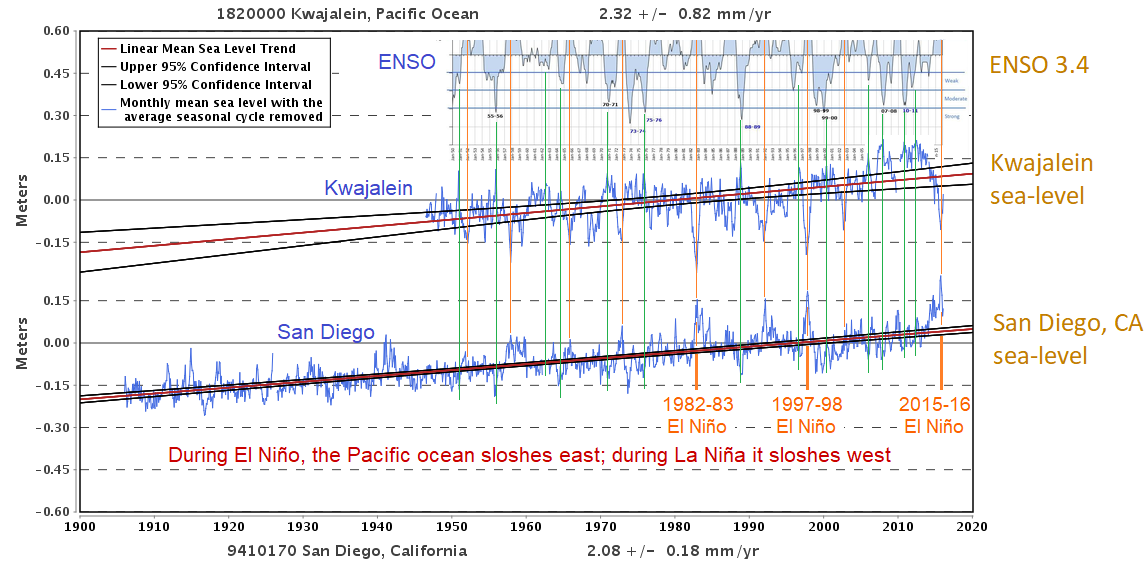
(One of the nice things about Honolulu is that it is near the ENSO "teeter-totter pivot point," so, unlike other long Pacific sea-level measurement records, Honolulu's is scarcely affected by ENSO.)
Another example of regional effects is the southeastern United States, where Gulf Stream variations are apparently the cause of well-known multi-decadal fluctuations in sea-level trends. For a discussion see Zervas (2009), NOAA Technical Report NOS CO-OPS 053, Sea Level Variations of the United States, 1854-2006. Here's a relevant excerpt:
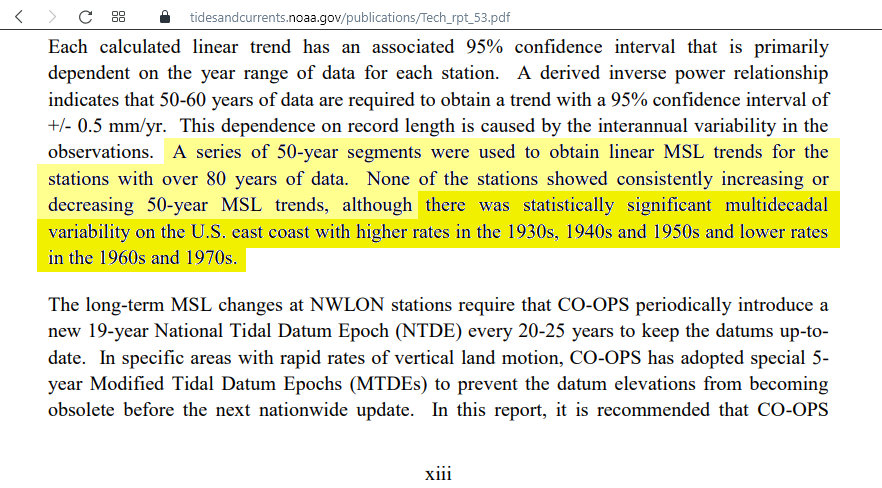
-
One Planet Only Forever at 01:16 AM on 7 July 2023Hansen predicted the West Side Highway would be underwater
Eclectic @26,
Indeed it can be hoped that people will turn over a new leaf if they developed a liking for and acted on a "...ratio of disinformation to information...".
it is important to appreciate that it is unacceptable for any presentation of misunderstanding to be paired with a lack evidence of a passion to learn to be corrected and evidence of significant interest and effort to limit and repair damage done by the incorrect belief and sharing of the misunderstanding.
Note that the seed for effective disinformation is a kernel of truth. No matter how much truth is part of a presentation of disinformation (a deliberate creation and sharing of misunderstanding) the presentation is still 'harmful disinformation'.
PR and marketing experts are well aware of the knowledge that "The Whole Truth and Nothing but the Truth" has a significant disadvantage in competitions for popularity or profit.
-
Bob Loblaw at 00:59 AM on 7 July 2023Hansen predicted the West Side Highway would be underwater
Rob @ 25, Eclectic @ 26.
Oh, I think it is almost certain that our daveburton and "the other Dave Burton" are one and the same, but Tamino's posts give extensive detail that applies to daveburton's arguments whether it is the same person or not.
Tamino's posts also give considerable detail on the background of the other Dave Burton that give a pretty good idea of where the other Dave Burton's biases might originate. The other Dave Burton has peddled his wares at other blogs that I have seen - RealClimate, and And Then There's Physics.
-
Eclectic at 16:01 PM on 6 July 2023Hansen predicted the West Side Highway would be underwater
Rob Honeycutt @25 ,
thanks for that info. I did come across a Dave Burton and his SeaLevel website a couple of years back (via the illustrious WUWT, iirc). But I soon gave up on his "sealevel" site, because the ratio of disinformation to information was excessively high.
Perhaps he is in the process of turning over a new leaf ~ and will now provide some useful scientific info & analysis. Hope springs eternal, eh.
-
Rob Honeycutt at 12:48 PM on 6 July 2023Hansen predicted the West Side Highway would be underwater
I'm reasonably certain this is the same Dave Burton, Bob. I've come across him many times over the years. He operates the sealevel.info website. He's making the exact same claims. He's an IT guy who fancies himself an expert on sea level rise.
-
prove we are smart at 11:31 AM on 6 July 2023The melting Arctic is a crime scene. The microbes I study have long warned us of this catastrophe – but they are also driving it
Interesting and informative, I really enjoyed this one. Another example of what our flawed human nature is causing.. How to give the "Overview Effect" to the people who can change things? I wish I knew.en.wikipedia.org/wiki/Overview_effect
-
Rob Honeycutt at 10:50 AM on 6 July 2023How big is the “carbon fertilization effect”?
Here's a graph for the Henry's Law Constant.
-
Bob Loblaw at 10:50 AM on 6 July 2023Hansen predicted the West Side Highway would be underwater
Oh, my. Commenter daveburton is certainly sending a lot of information our way. I am going to focus on his sea level acceleration claims in comment #10. In that comment, he links to two US locations (The Battery, in the NYC area, and Honolulu) for tide/sea level data, and gives us some quadratic equations to make a claim that sea level rise is negligible, and not much of a worry for the future.
Most regular readers here will also be familiar with Tamino's blog. Although Tamino has not been particularly active recently, over the years he has done a number of posts on analysis of sea level data. It turns out that a lot of those posts have the name "Dave Burton" showing up in them, either as a source of information that Tamino is debunking, or (on a few) as a commenter.
Now, I have no way of knowing whether our daveburton is the same Dave Burton seen in the discussions at Tamino's, but there is a similarity: they both like using The Battery and Honolulu stations as examples, and they both like fitting quadratic equations and arguing that there is little or no evidence for acceleration in sea level rise. To avoid confusion, I'll refer to the Dave Burton that is discussed at Tamino's as "the other Dave Burton".
I don't have the space or time to try to re-write everything that Tamino has written, so I'll just link to a few of his posts on the matter (well, nine) and provide very brief summaries.
The first Tamino post is from 2012, titled Unnatural Hazards. The other Dave Burton's name shows up quite a few times, although he does not comment. Tamino looks at The Battery data, plus a global sea level data set, and demonstrates why a quadratic fit is unsuitable. He also shows clear acceleration in the data. To provide a little graphic input for this comment, I'll included two of Tamino's figures:
A graph of the seasonally-detrended sea level at The Battery:

And a graph showing the rate of sea level change:
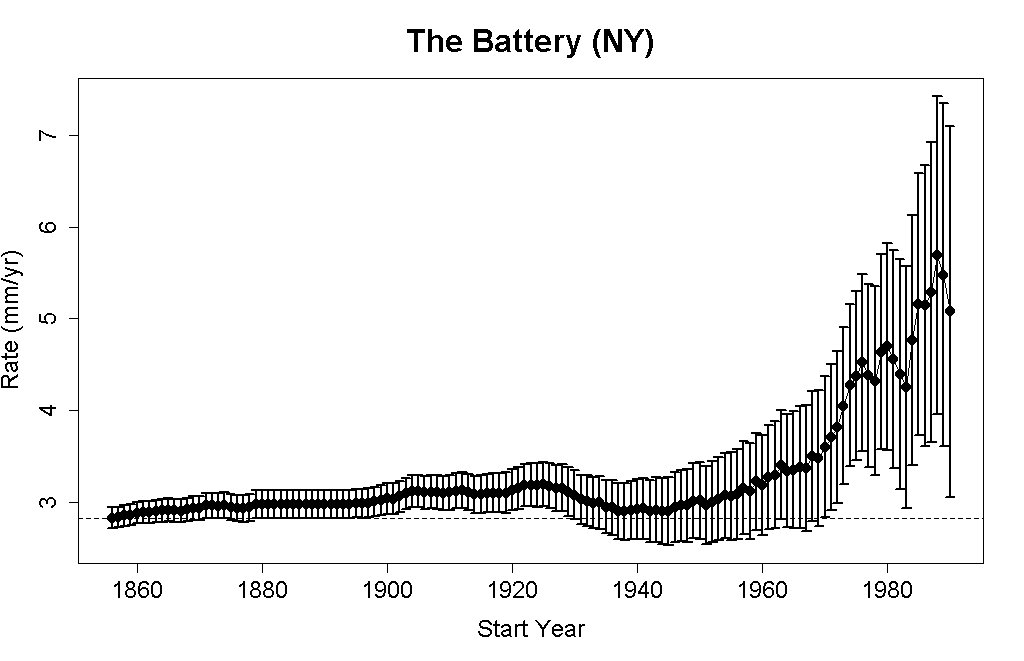
I"ll let you decide if you think this shows acceleration. Read Tamino's post for further details.
The next Tamino post isn't until October 2019. He had five posts from October to December, covering the following:
- Sea Level Rise. This post looks at acceleration in several global data sets, finding it present. The other Dave Burton comments extensively, and claims that "Honolulu is a nearly ideal place for sea-level measurement". He uses a quadratic equation to look for acceleration (and basically says it isn't significant).
- The next Tamino post is on Sea Level Acceleration. This post was prompted by the comments from the other Dave Burton on the previous post. Tamino looks at San Diego, Key West, Boston, St. Petersburg (FL), and Honolulu. Honolulu is the only one without acceleration. Tamino uses changepoint analysis to look for changes in linear trend. (Spoiler alert: he finds changes.)
- Further comments from the other Dave Burton lead to Tamino's next post, on Sea Level Accleration Denial. Tamino goes into more detail on the folly of the other Dave Burton's quadratic analysis, and explains more aspects of statistical testing for acceleration.
- Tamino's final October post is on Sea Level: Eastern North America. This post only has a passing mention of the other Dave Burton, but it is another excellent analysis along the entire east coast from the Caribbean to Canada.
- In December, we see another post on A Century and More of Sea Level Acceleration. Also only a passing mention of the other Dave Burton, but this post looks at several different sea level data sets, and includes more acceleration analysis.
It isn't until November 2021 that we see another Tamino post where the other Dave Burton is mentioned. This one is titled North Carolina Sea Level Rise: Problem Not Solved. (The other Dave Burton first came on the scene, arguing against forcing North Carolina developers to include future rapid rising sea levels in their planning.) Tamino quickly followed the first November post with another, titled Sea Level at Wilmington, NC (and other places). This adds another North Carolina station to the analysis.
And finally, in February 2022, Tamino posted on Sea Level Denial, where the other Dave Burton's name comes up again. This post has further looks at Wilmington, Cedar Key, Pensacola, and Key West.
Again, our daveburton posting here may not be the same as the other Dave Burton, but the arguments are much the same - and rife with the same errors. Let's hope that our daveburton can read Tamino's posts and learn from them The other Dave Burton certainly did not.
-
Rob Honeycutt at 10:46 AM on 6 July 2023Hansen predicted the West Side Highway would be underwater
Dave... "Due to the temperature dependence of Henry's Law, a 1°C increase in temperature slows CO2 uptake by the oceans by about 3%."
Moving this to an appropriate thread.
-
Rob Honeycutt at 10:45 AM on 6 July 2023How big is the “carbon fertilization effect”?
Moved from another thread.
Dave... "Due to the temperature dependence of Henry's Law, a 1°C increase in temperature slows CO2 uptake by the oceans by about 3%."
Where do you come up with this 3% figure?
-
Rob Honeycutt at 10:06 AM on 6 July 2023Hansen predicted the West Side Highway would be underwater
Dave @19... "Rob wrote, "that greening is now turning into 'browning.'" Well, here's what AR6 shows:"
This is absolutely classic.
1) That is not an image that appears in AR6, not with the added orange box. Thus you're co-opting their work to infer conclusions they do not make.
2) The caption for FAQ 5.1 is stating exactly what I've been explaining to you:
For decades, about half of the carbon dioxide (CO2) that human activities have emitted to the atmosphere has been taken up by natural carbon sinks in vegetation, soils and oceans. These natural sinks of CO2 have thus roughly halved the rate at which atmospheric CO2 concentrations have increased, and therefore slowed down global warming. However, observations show that the processes underlying this uptake are beginning to respond to increasing CO2 in the atmosphere and climate change in a way that will weaken nature’s capacity to take up CO2 in the future. Understanding of the magnitude of this change is essential for projecting how the climate system will respond to future emissions and emissions reduction efforts. [emphasis added]
Therefore, quite clearly, you are using this graph completely out of context and using without understanding any of the underlying physics or research on the issue.
You are merely crafting tidbits to confirm your personal biases.
And, Dave, pointing out that you don't have the requisit training in this subject is not ad hominem. I don't have the training either, but I'm not making statements that directly contradict what the leading researchers in the field are saying.
-
Philippe Chantreau at 10:00 AM on 6 July 2023Hansen predicted the West Side Highway would be underwater
I will respond to Dave Burton on the CO2 fertilization thread on the part of this latest post regarding that subject.
-
One Planet Only Forever at 08:00 AM on 6 July 2023Hansen predicted the West Side Highway would be underwater
daveburton,
I will try to limit how much I repeat any of the assistance others have provided to increase your awareness and improve your understanding of the issues. I will try to focus on aspects of your response @10 that have not yet been addressed.
I think it may be best to respond in reverse as follows.
Regarding: "Assumption #2: You seem to think that the CO2 level controls sea-level."
That is a misunderstanding of my comment. I am aware of and understand the following Common Sense Consensus knowledge:
Increased CO2 levels will result in a warmer global average surface temperature resulting in the reduction of the amount of water that is stored as ice supported by land (melting of ice supported by water does not change the level - unless the melting of that ice accelerates the flow of land supported ice to the ocean). Most of the water that is no longer "ice supported on land" will drain into the oceans resulting in a higher sea level (and this process will take a long time to reach a balanced state after CO2 levels stop increasing).
In addition to the sea level change due to melted ice, an increased level of CO2 in the atmosphere will result in an increased average temperature of the oceans. And water expands as it warms resulting in a higher average sea level in addition to the melted ice impact.
Regarding: "Assumption #1: You assume that there's such a thing as "a locked-in doubling of CO2.""
I was not assuming anything. I was presenting a hypothetical situation for consideration. That situation is a case where CO2 levels reach 560 ppm and stay at that level due to continued human impacts.
Simply asking what the sea level will be when CO2 levels reach 560 ppm will result in a vast range of answers. There are a diversity of cases where CO2 levels reach 560 ppm that would have significantly different expected maximum sea level rise. They include the following:
- CO2 rapidly reaching 560 ppm and continuing to rapidly increase. That will produce a low amount of sea level increase at the moment that 560 ppm is reached. But it would cause a much higher level in the distant 'balanced condition' of the future that will be established at some significant time after CO2 levels are no longer being increased.
- CO2 levels slowly reaching 560 ppm and continuing to slowly increase. That would result in a higher sea level when 560 ppm is reached that in case 1. But if the same 'maximum ppm level' as in case 1 is reached then the long term sea level rise would likely be comparable to case 1.
- CO2 level increases to 560 ppm then is held steady by continued human impacts (a locked in level of CO2). This is the case I was referring to. Indeed you misunderstood my comment.
- CO2 levels rise to 560 ppm and then are rapidly reduced by human industrial CO2 removal or other human impact changes that result in reduction of CO2 levels rather than a steady level of 560 ppm. This is closer to what an ethical consideration would conclude. The more ethical conclusion is that CO2 levels should not be allowed to reach 560 ppm. And human actions to remove CO2 from the atmosphere are required even though the CO2 levels do not reach 560 ppm.
Finally regarding your opening statement: "...why are you asking me "about the human origins of global warming"? My comment had nothing to do with that."
I was not asking a question. I was pointing out that the information you provided did not affect the conclusion of the OP. Your comment could be considered to be an attempt to use a 'new twist' of the "Hansen got it wrong" claim.
That raises a new question. Why did you make the claim you made @8?
-
daveburton at 07:39 AM on 6 July 2023Hansen predicted the West Side Highway would be underwater
Rob wrote, "that greening is now turning into 'browning.'"
Some people point to that little orange box and say that greening has ceased. That reminds me of the folks who say that the it's not as warm as the 2015-16 El Nino, so warming has ceased.
Philippe wrote, "There is probably a better thread for this argument,"I agree. I was just trying to address OnePlanet's remark about a "locked in" CO2 level.
Philippe wrote, "There is only one factor that truly controls how green any region can be: water availability."
That's a common misconception. Elevated CO2 levels greatly improve plants' water use efficiency (WUE) and drought resilience. That's why elevated CO2 is especially beneficial for crops when under drought stress. It has been heavily studied by agronomists. Here's a paper about wheat:
Fitzgerald GJ, et al. (2016) Elevated atmospheric [CO2] can dramatically increase wheat yields in semi-arid environments and buffer against heat waves. Glob Chang Biol. 22(6):2269-84. doi:10.1111/gcb.13263.
Philippe wrote, "The experiences that have shown a CO2 fertilization effect were done in very controlled conditions and involved extremely high concentrations (800 ppm and up)."
That's incorrect. All major crops have been studied, and all benefit from elevated CO2. It is true that the greatest benefits accrue at 1000 ppmv or higher, but even modest CO2 increases significantly improve crop yields.
This recent study quantifies the effect for several major crops. Their results are toward the high end, but their qualitative conclusion is consistent with many, many other studies. They reported, "We consistently find a large CO2 fertilization effect: a 1 ppm increase in CO2 equates to a 0.4%, 0.6%, 1% yield increase for corn, soybeans, and wheat, respectively."
This study evaluated pine trees:
Idso, S., & Kimball, B. (1994). Effects of atmospheric CO2 enrichment on biomass accumulation and distribution in Eldarica pine trees. Journal of Experimental Botany, 45, 1669-1672.
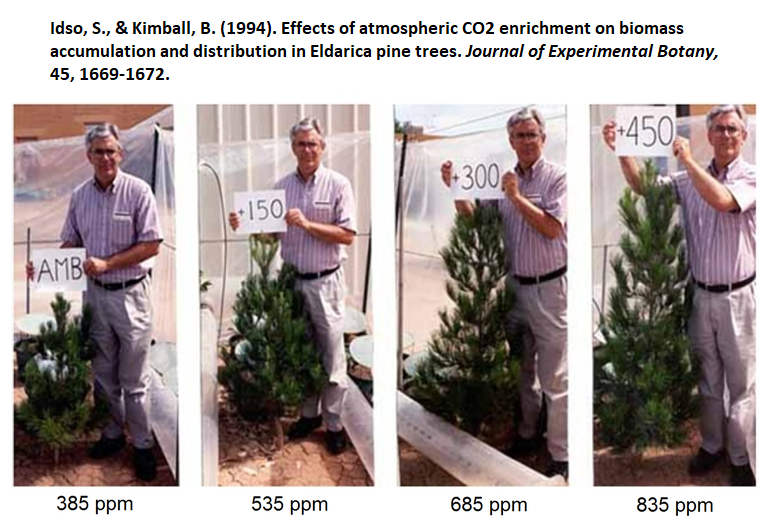
As you noted, the effect is greatest with CO2 >800 ppmv, but, as you can see, even a much smaller CO2 increase has a substantial effect.
Rob wrote, "This entire paragraph is patently absurd and completely fabricated."It is 100% factual, Rob. I'm surprised that you didn't already know it.
These figures are from that same AR6 Table 5.1 excerpt which I already showed you:
average CO2 removal rate in the 2010s = 2.7707 ppmv/yr
average CO2 removal rate in teh 2000s = 2.3481 ppmv/yrThese figures are from Mauna Loa:
average CO2 level in the 2010s = 399.91 ppmv
average CO2 level in the 2000s = 378.84 ppmv(399.91-378.84) / (2.7707-2.3481) = 49.86
So a 50 ppmv increase in CO2 level accelerates the natural removal rate by about 1 ppmv/year.
49.86 / 2.1294 = 23.42 ppmv increase yields a +1 PgC removal rate increase.
I encourage you to do the calculations yourself for any other time period of your choice.
If you have the natural removal rate as a function of CO2 level (which we do), it is trivial to simulate the CO2 level decline if emissions were to suddenly cease. I wrote a little Perl program to do it; email me if you want a copy.
Rob wrote, "if true, the oceans would just continue to suck up all the atmospheric CO2 and we'd live on a frozen planet."
That's incorrect. The system progresses toward equilibrium, which is below 300 ppmv, but not zero.
Rob wrote, "rather that starting from a prior where all the published science is getting it wrong, and making stuff up... you don't have the requisite training to fully grasp the topic"
Rob, it's not necessary to resort to ad hominem attacks. I'm happy to document things that are surprising to you. You need but ask. Everything I've written is well-supported.
Rob wrote, "take some time to fully familiarize yourself with Henry's Law."
Due to the temperature dependence of Henry's Law, a 1°C increase in temperature slows CO2 uptake by the oceans by about 3%. But a 50% (140 ppmv) rise in atmospheric CO2 concentration accelerates CO2 uptake by the oceans by 50%. That's the main reason that ocean uptake of CO2 continues to accelerate.
-
michael sweet at 07:27 AM on 6 July 2023Hansen predicted the West Side Highway would be underwater
Dave Burton:
I note that the last time Carbon dioxide was over 400 ppm the sea level was more than 20 meters higher than current sea level.
Your sea level graphs are obviously flawed. A simple eye ball look at the data from the Battery in New York shows that at the start of the time period the data is above the fit line and at the end of the time period the data is way above the fit line. That means that the line does not fit the data and some sort of curved line is needed because the rate of sea level rise is increasing over the time period you chose.
In addition, you have cherry picked two single locations to do your calculations without justifying your choice.
Fortunately, Tamino did an analysis of sea level rise before he stopped posting analysis. (Tamino is a professional statistical data analyzer who has published on sea level rise). He analyized "the data for every tide gauge station in region 3 which had at least 360 months’ data (at least 30 years), at least 120 months of which (10 years of which) are since the year 2000 — after all, we do want to know what’s happening now. That leaves 10 stations". Since he used all the available data his data is not cherry picked like yours is.
Here is one of his graphs of the rate of sea level rise on the East coast of the Gulf of Mexico:

We see immediately that sea level rise does not follow a straight line but varies over the 100 year time from of analysis. Of particluar interest is the dramatic increase in sea level rise since 2010.
The dramatic increase in sea level rise observed since 2010 holds true for an analysis of the entire globe. Your analysis using a linear fit is simply incorrect and cherry picked.
I note that the rate of rise since 2010 is more than double all the previous rates.
We would expect that if the carbon dioxide content of the atmosphere remains above 400 ppm that the sea level will rise 20 meters plus. The question is only how fast the sea will rise. We see the rise is rapidly increasing every year now. Your linear fit deliberately hides the observed rise.
I note that the change in CO2 concentration in the atmosphere has rapidly increased over the past 50 years so one would expect the sea level change to rapidly increase over that time period. Including the data back to 1900 with a linear fit just hides the recent rapid increase in sea level rise.
Does anyone know how Tamino is doing?
-
nigelj at 07:16 AM on 6 July 2023At a glance - Ocean acidification: Global warming's evil twin
From Woods Hole Oceanographic Institution :
One of the most common negative responses Sarah Cooley gets when she speaks to community groups about ocean acidification is, “What do you mean, ocean acidification? The ocean is not acidic! Seawater is never going to get below pH 7—so you must not know what you’re talking about.
That’s partly true, said Cooley, a postdoctoral researcher at Woods Hole Oceanographic Institution. The pH of seawater is near 8, which makes it mildly alkaline, or basic; but any decrease in the pH of a liquid is considered “acidification.”
“It’s a lot easier to say ‘ocean acidification’ than ‘ocean de-alkalinization,” said Cooley.
pH is an index of how many protons, or hydrogen ions (H+) are dissolved and free in a solution. The pH scale goes from 0 to 14. A fluid with a pH of 7 is neutral. Below 7, it is acidic; above 7, it is alkaline.
A small drop in pH means big change in acidity: The pH of seawater is near 8, which makes it mildly alkaline, or basic; but any decrease in the pH of a liquid is considered “acidification.” The key danger factor is an increase in dissolved hydrogen ions.(Woods Hole Oceanographic Institution)
The more below or above 7 a solution is, the more acidic or alkaline it is. The scale is not linear—a drop from pH 8.2 to 8.1 indicates a 30 percent increase in acidity, or concentration of hydrogen ions; a drop from 8.1 to 7.9 indicates a 150 percent increase in acidity. Bottom line: Small-sounding changes in ocean pH are actually quite large and definitely in the direction of becoming less alkaline, which is the same as becoming more acidic.
If you think about it, we use descriptive words like this all the time. A person who stands 5’5” tall and weighs 300 pounds isn’t thin. If he loses 100 pounds, he still won’t be thin, but he will be thinner than he was before he went on the diet. (And we are more likely to comment that he’s looking trimmer than to say he’s not as fat as he used to be.)
-
Rob Honeycutt at 04:13 AM on 6 July 2023Hansen predicted the West Side Highway would be underwater
Dave, I think you should take some time to fully familiarize yourself with Henry's Law. Here's a starter teaching video, but don't stop there. Dig deeper and really learn what this means in relation to the ocean/atmosphere relationship for CO2.































 Arguments
Arguments





















